If you'd like to serve up an incredible showstopper of a fish dinner in just 20 minutes, try this mild, delicious pan-fried Yellowtail on a bed of herby, garlicky tagliatelle.
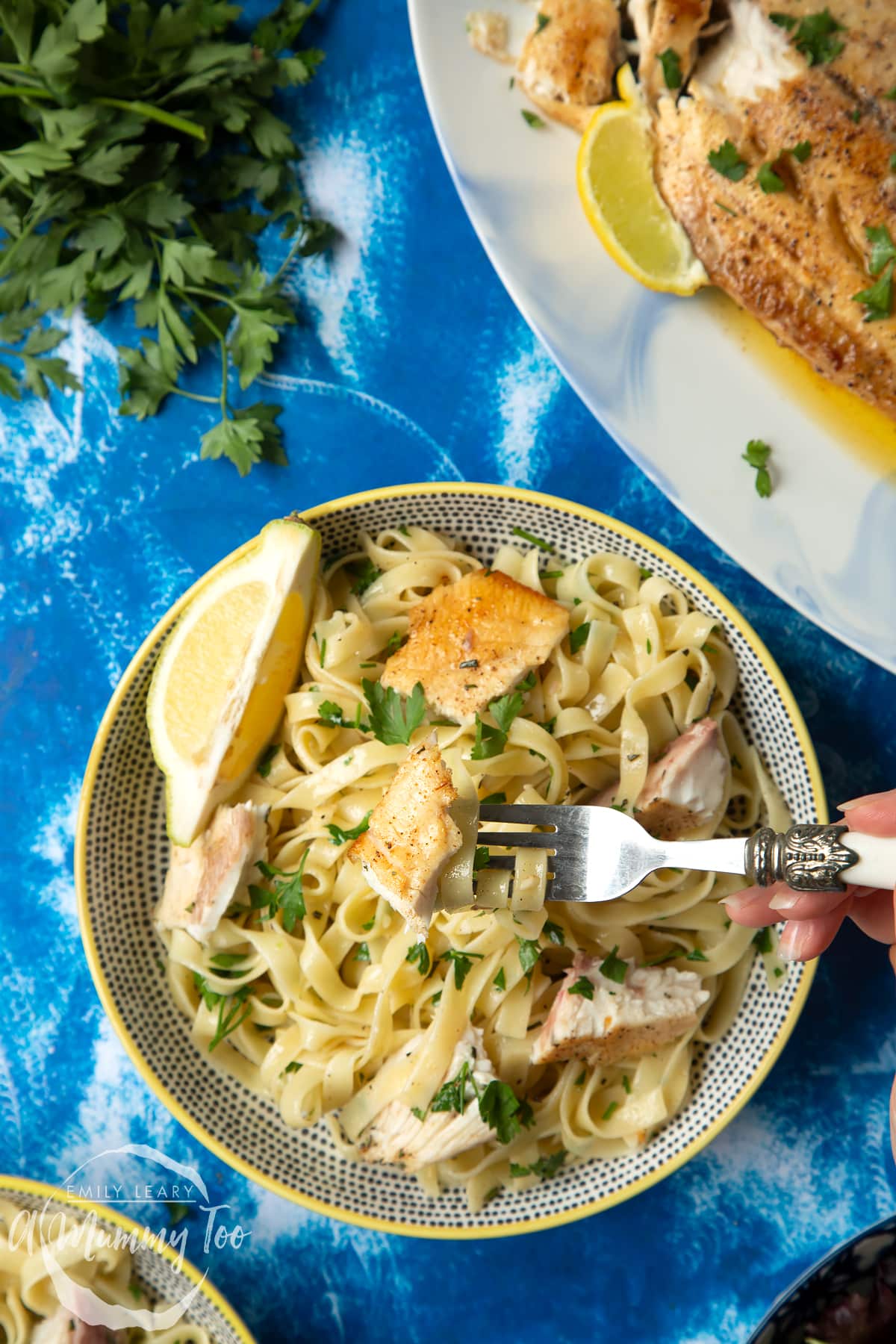
For this delicious recipe, we'll pan-fry a gorgeous Dutch Yellowtail fillet in lashings of butter for a crisp, delicious skin, then serve it with lemon and parsley.
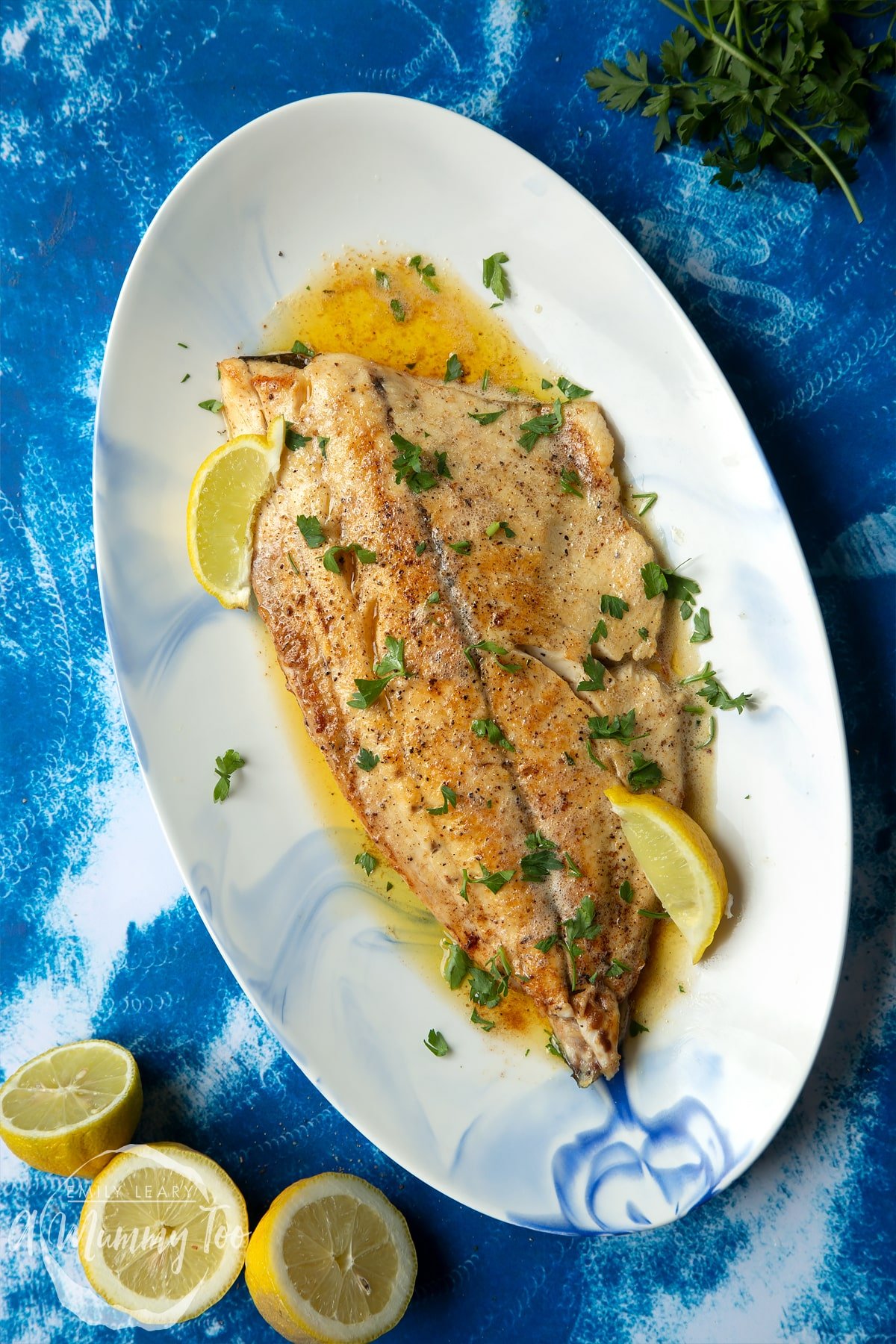
But we won't let all that gorgeous infused butter go to waste. We'll toss al dente tagliatelle into the pan with parsley and rosemary, before serving the herby pasta and buttery Yellowtail up together to create an easy yet eye-catching dinner that will have the whole family drooling!
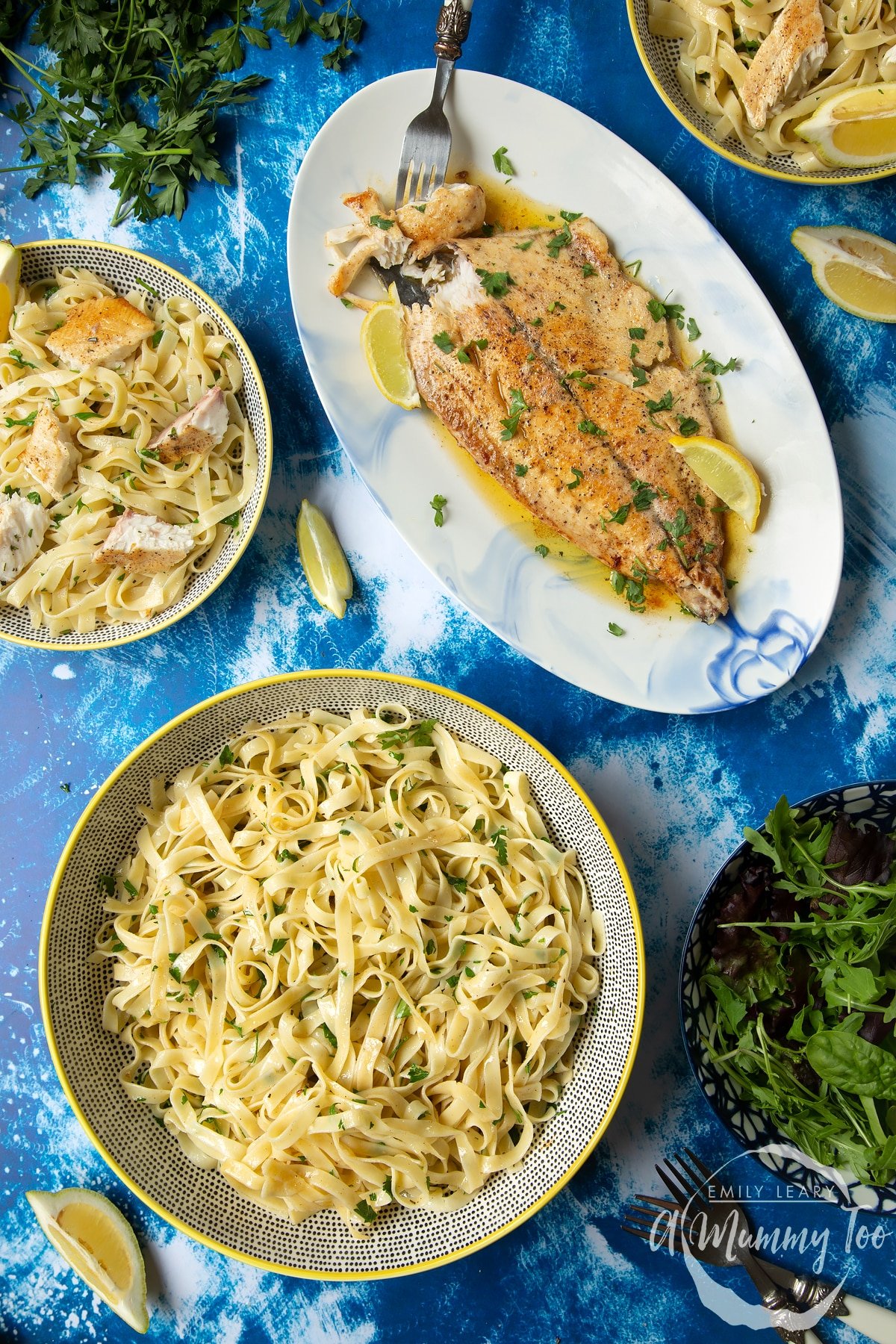
For this recipe, I'm using Dutch Yellowtail - also known as Hiramasa or Kingfish and not to be confused with Yellowfin tuna.
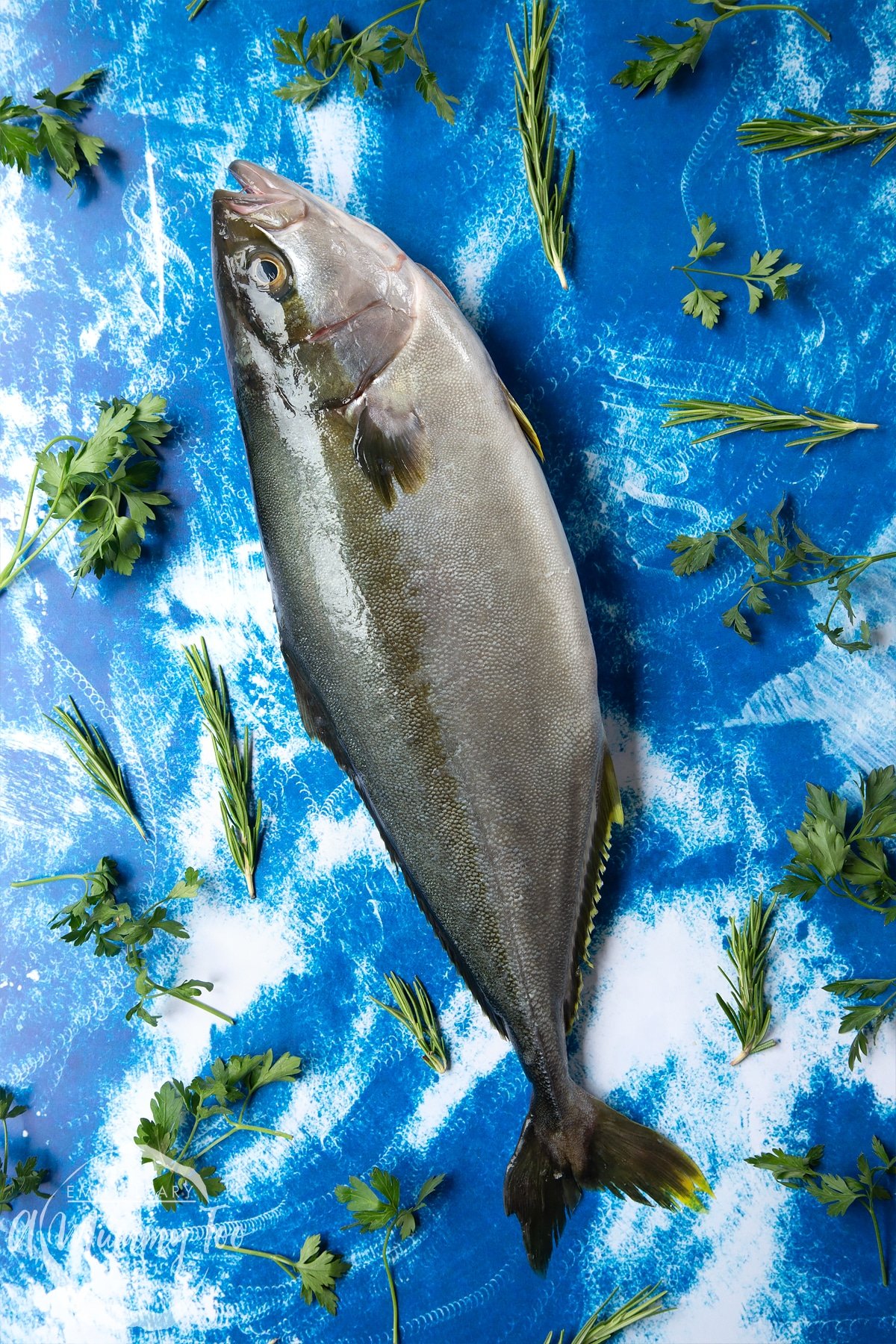
Dutch Yellowtail is a large, high-quality fish with a pinkish-white flesh, a firm texture and a delicate taste that lends well to grilling, frying, steaming, poaching, roasting or slow-cooking. Sashimi-grade Dutch Yellowtail is also wonderful served 'crudo' (raw).
A typical whole Dutch Yellowtail measures about 50cm and they get their name from the distinctive yellow colour of their fins and tail. The upper half of their body (above the 'lateral line') also has a yellow hue.
As the Dutch part of their name would suggest, Dutch Yellowtail are raised in the Netherlands year-round by Kingfish Zeeland in the picturesque Zeeland province of the Netherlands.
Their Dutch Yellowtail thrive in fresh seawater drawn from the Eastern-Schelde waterbody which is part of a "Natura 2000" area and boasts some of the cleanest seawater to be found in all Europe. The water is filtered of any parasites or contaminants to give a pure environment for their fishes to grow healthily - no antibiotics, hormones, vaccines, or medication of any kind is used in their rearing,
All this means that they are not only a healthy, delicious choice but are also considered a sustainable alternative and recommended as a "Green Choice" by the Good Fish Foundation.
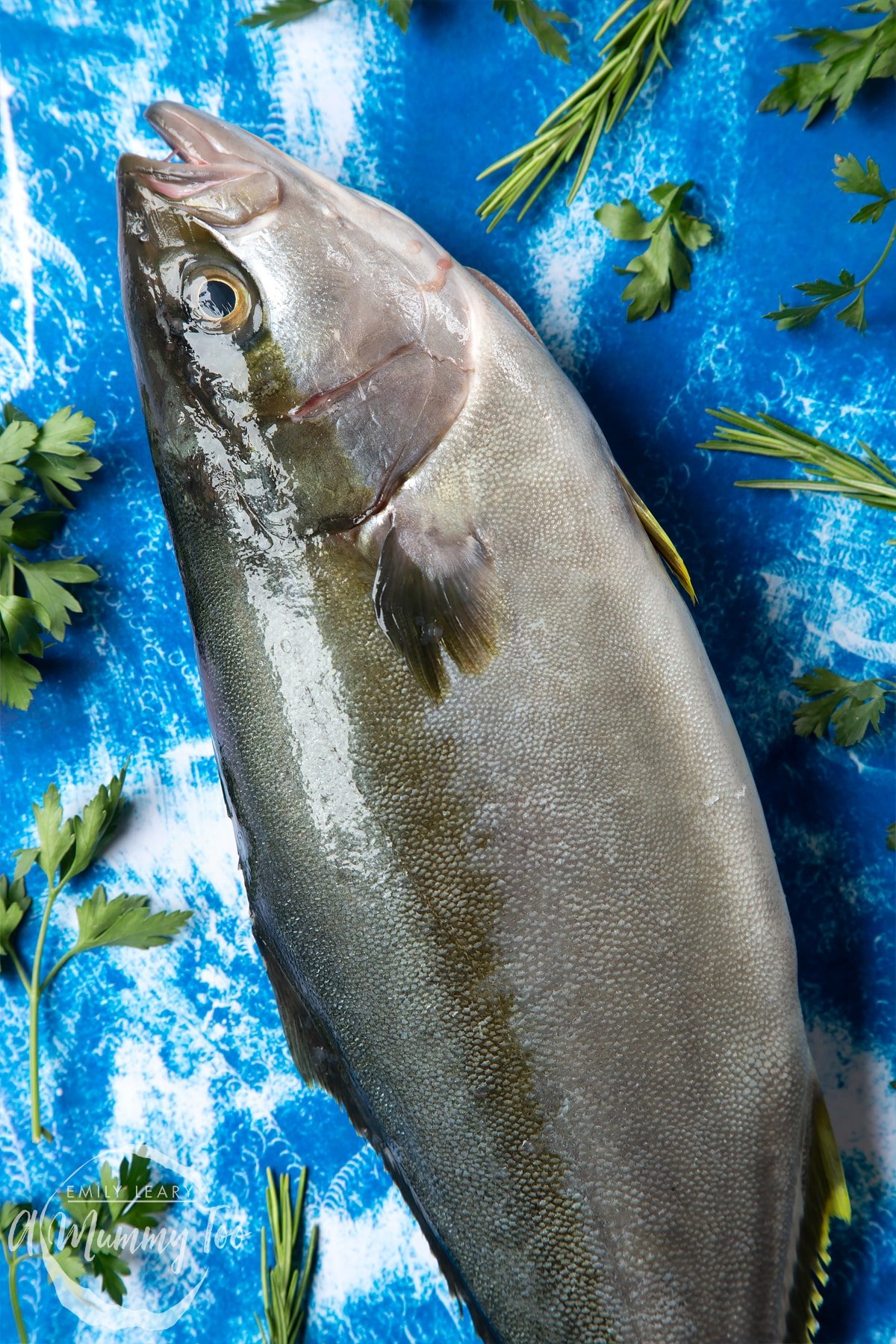
In addition, Dutch Yellowtail is a great source of protein and Omega 3 fatty acids that you can enjoy without fear of contaminants such as mercury or plastics.
Whole Dutch Yellowtail can be purchased from your fishmonger pre-gutted, ready to smoke, steam or bake.
For a simple, delicious meal, you could rinse, season and lightly oil the fish, stuff the cavity with rosemary sprigs and slices of fresh lemon, then bake for approximately 30 minutes until the flesh flakes.
You could also stuff the whole fish with fresh ginger, steam for about 8 minutes and serve with spring onion, coriander and soy sauce for a stunning, fresh tasting dish.
However, for this Pan-fried Yellowtail tagliatelle recipe, I'm using Dutch Yellowtail fillets.
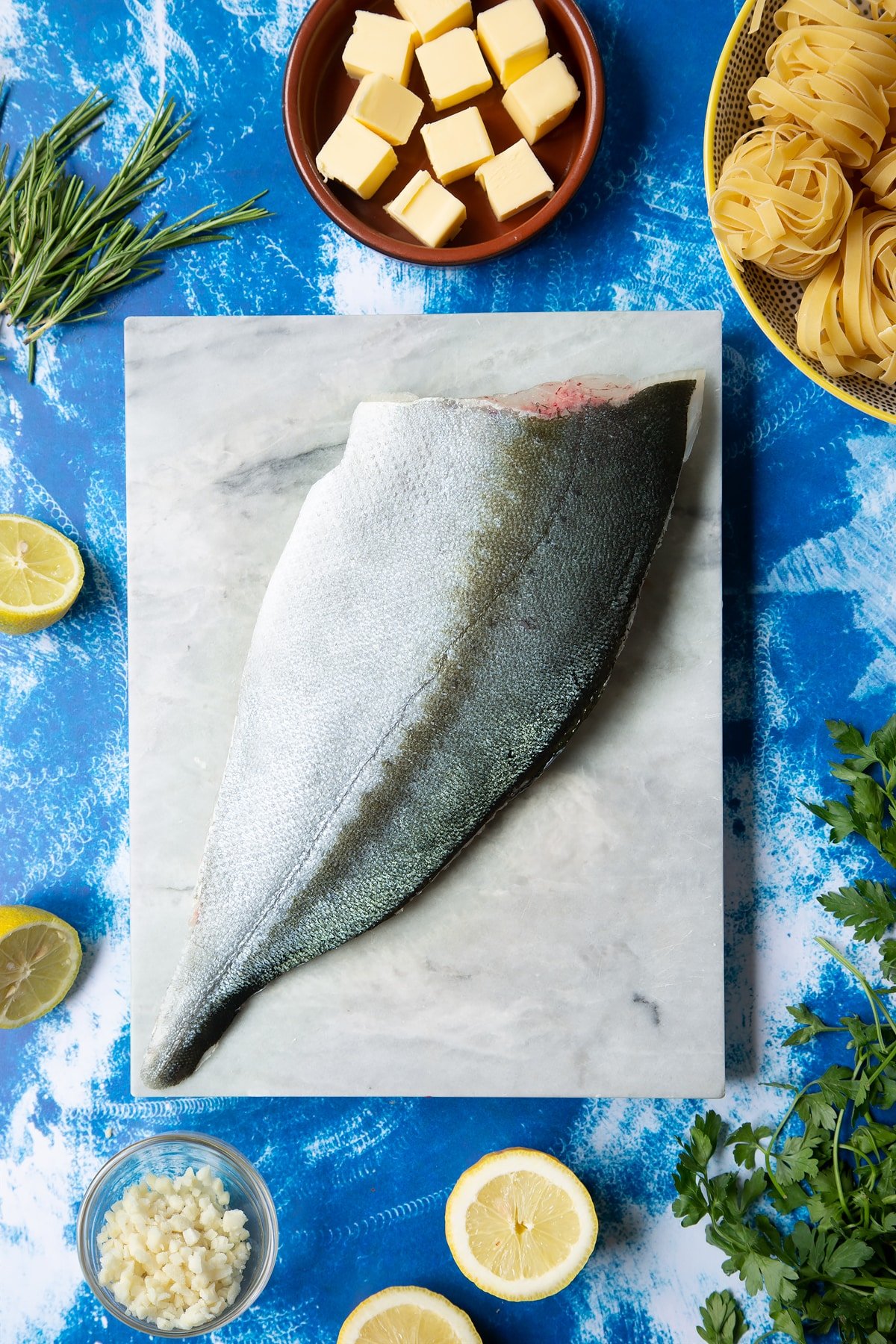
These fillets come skin-on and need very little prep, so they're super convenient.
Each fillet typically weighs in at a generous 300g-500g, so one Dutch Yellowtail fillet can feed 2-4 people. They're really easy to cook with, making them the perfect option for your next fish dinner!
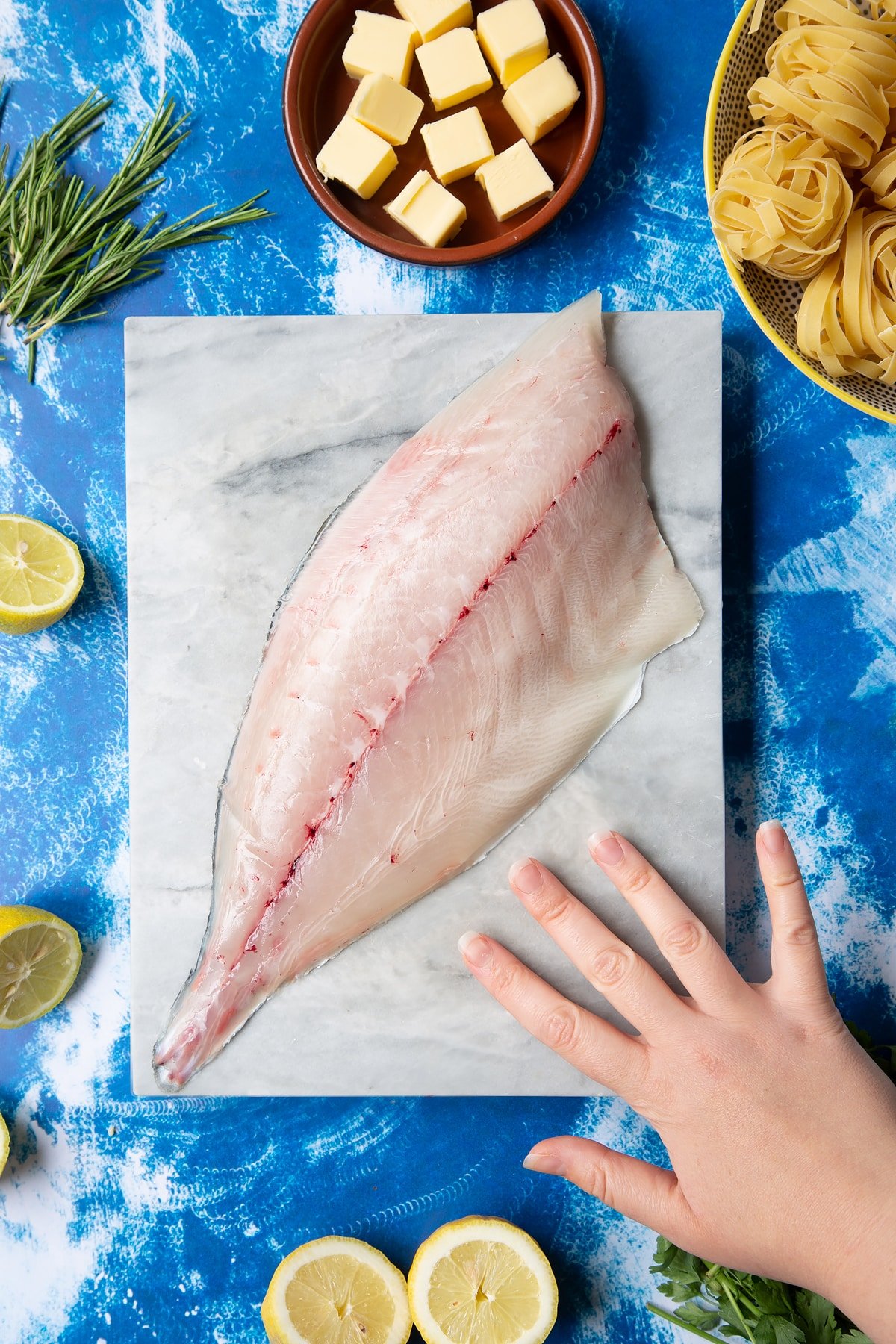
Here's how to make pan-fried Yellowtail tagliatelle.
Ingredients
- 500 g (18oz lb) Dutch Yellowtail fillet skin lightly scored
- 350 g (12 oz) dried tagliatelle
- 80 g (5 tbsp) salted butter
- 2 cloves (2) cloves chopped
- 20 g (⅔ cup) fresh rosemary leaves roughly chopped
- 5 g (2 tbsp) rosemary de-stalked and finely chopped
- 2 lemon cut into wedges
- salt and black pepper to taste
Instructions
In a large pan of salted water cook your pasta following the packet instructions. It should cook for no more than 10 minutes to become al dente (i.e. with a little bite).
Meanwhile, place the Dutch Yellowtail fillet on a clean surface and season with salt and pepper on both sides. (See the FAQ for notes on deboning, especially if serving to children.)
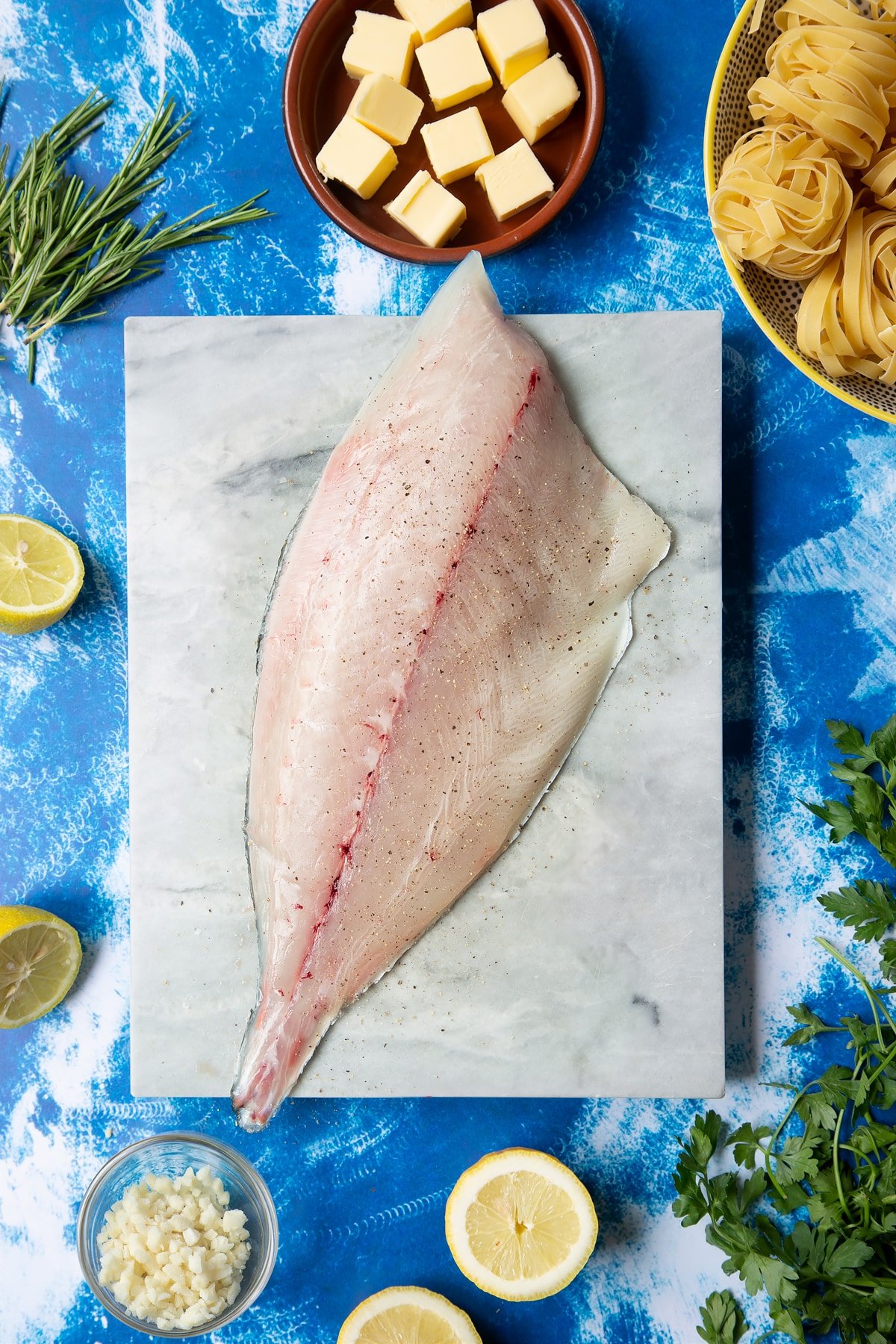
Lightly score the skin - the will prevent the fish from curling during cooking.
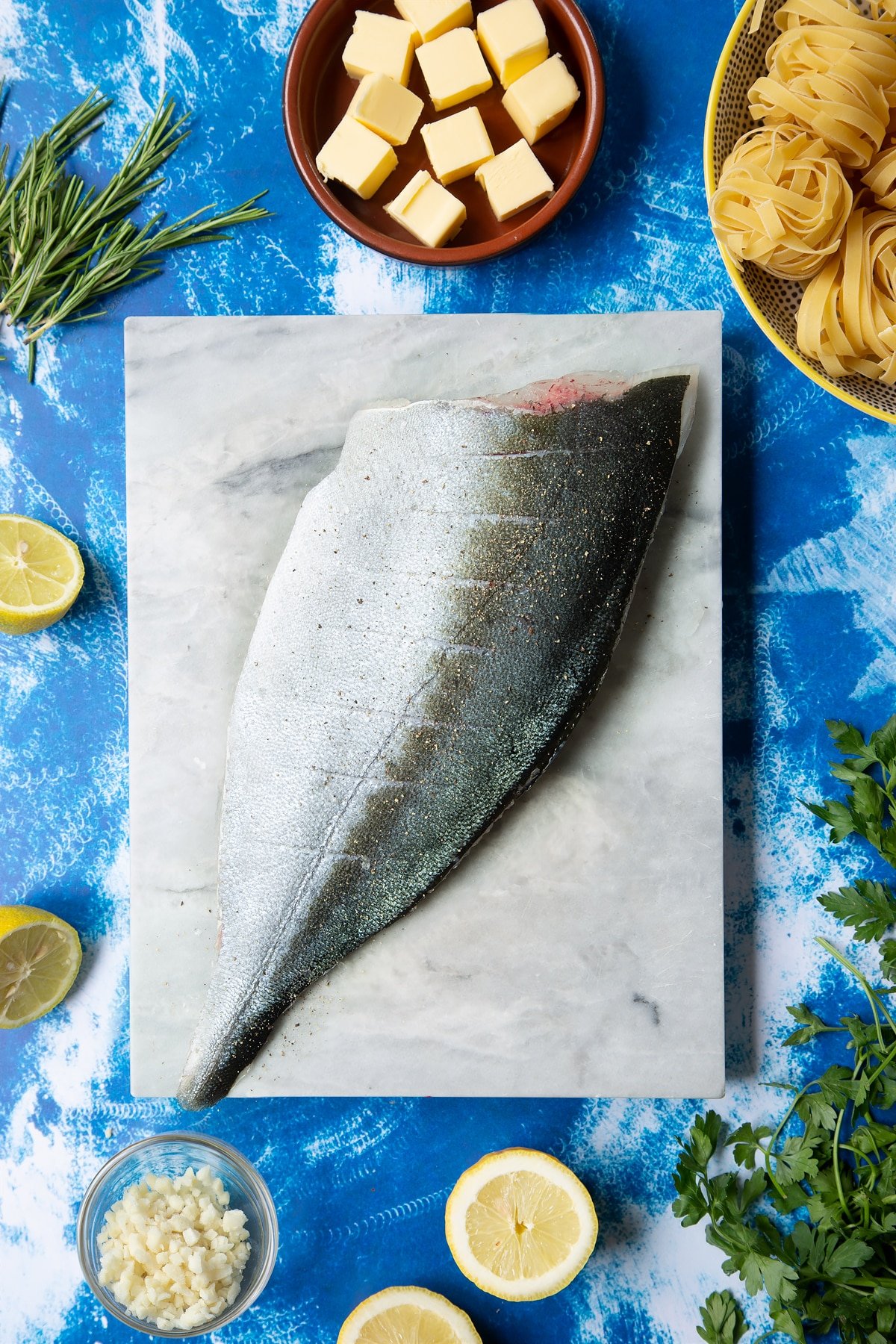
Place the butter in a large nonstick frying pan over a medium heat.
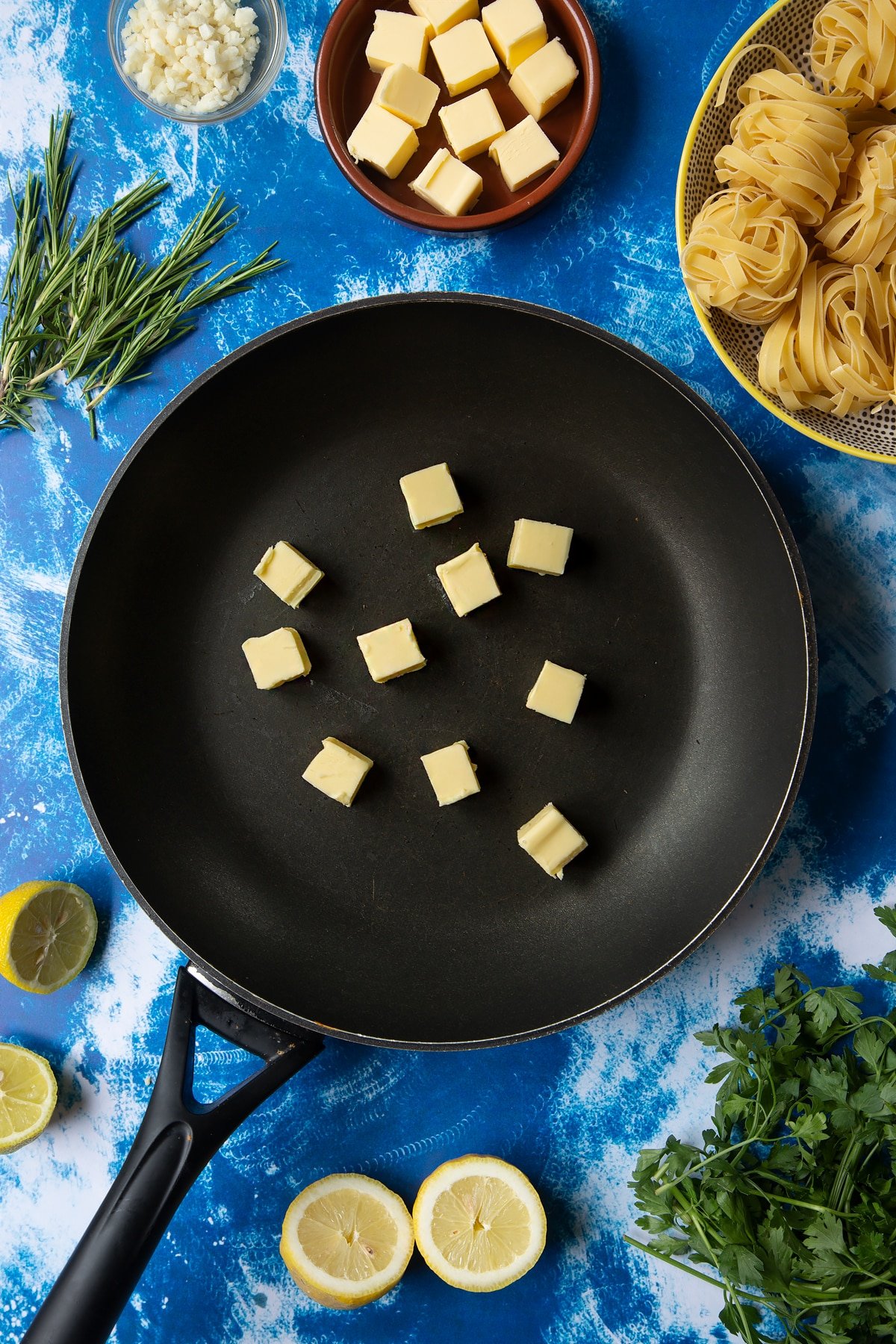
Melt.
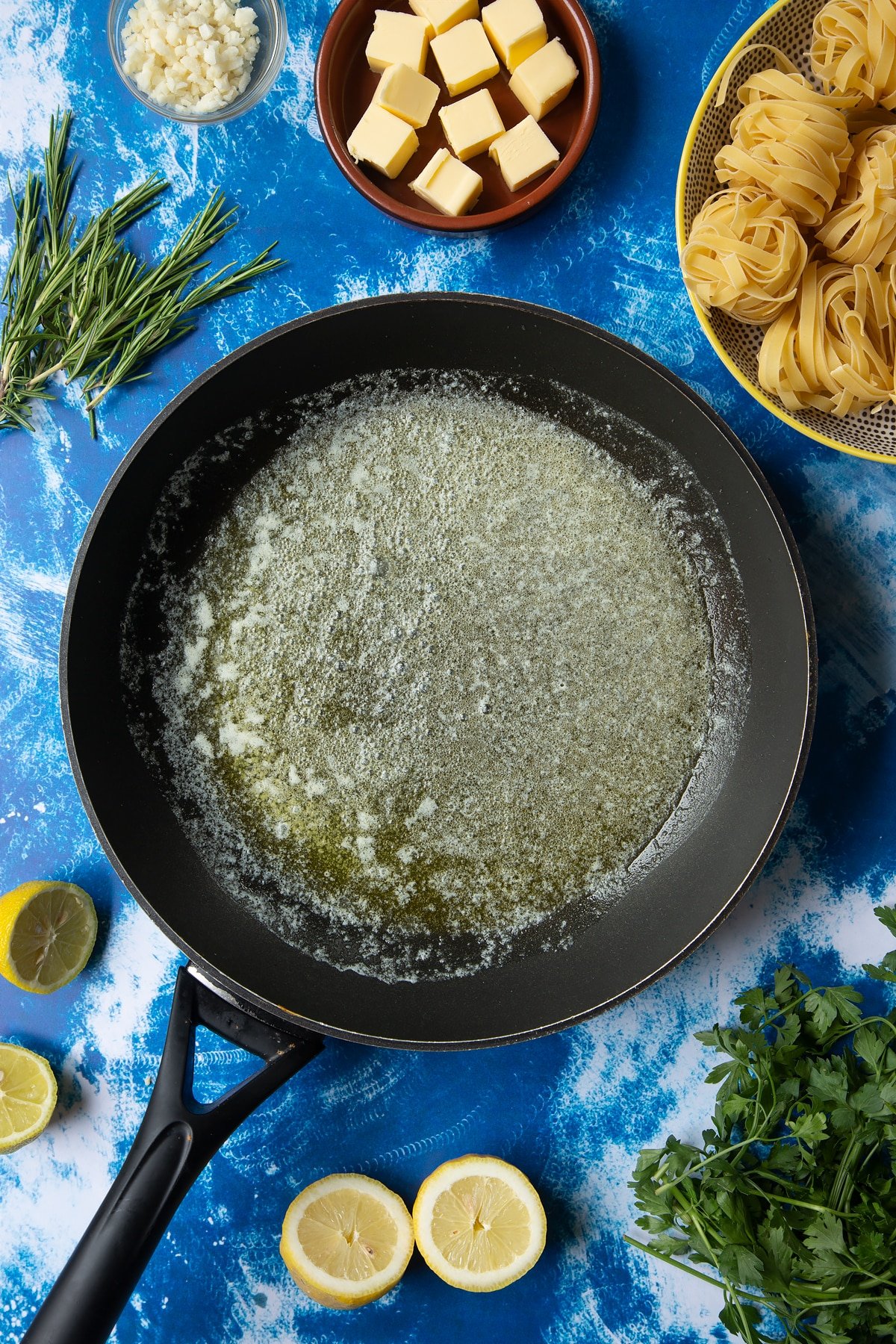
When the butter is gently bubbling, place the fish fillet in the pan, skin side down.
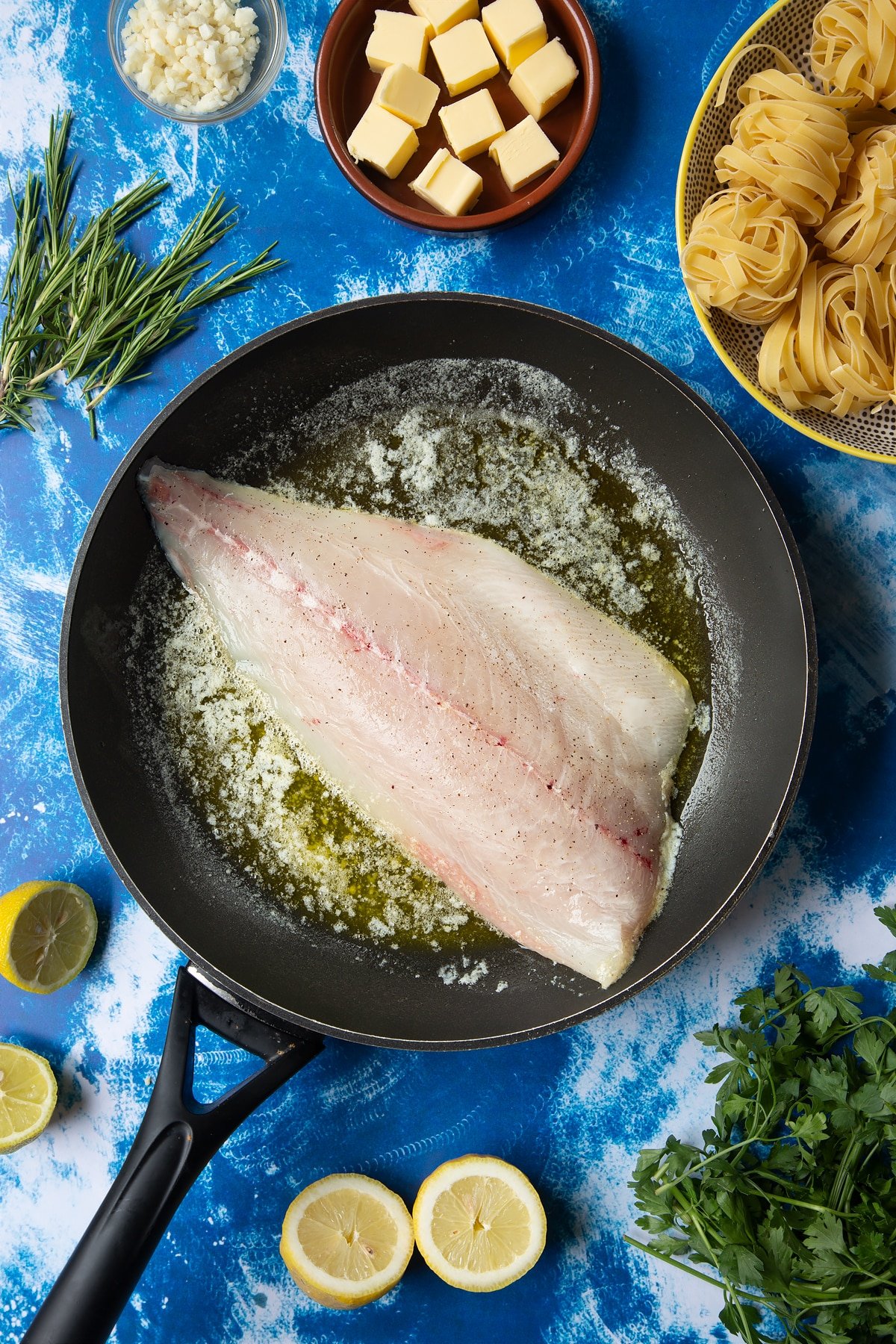
Cook until the skin is starting to go crisp, about 4 minutes. Carefully turn the fish using a slotted spatula.
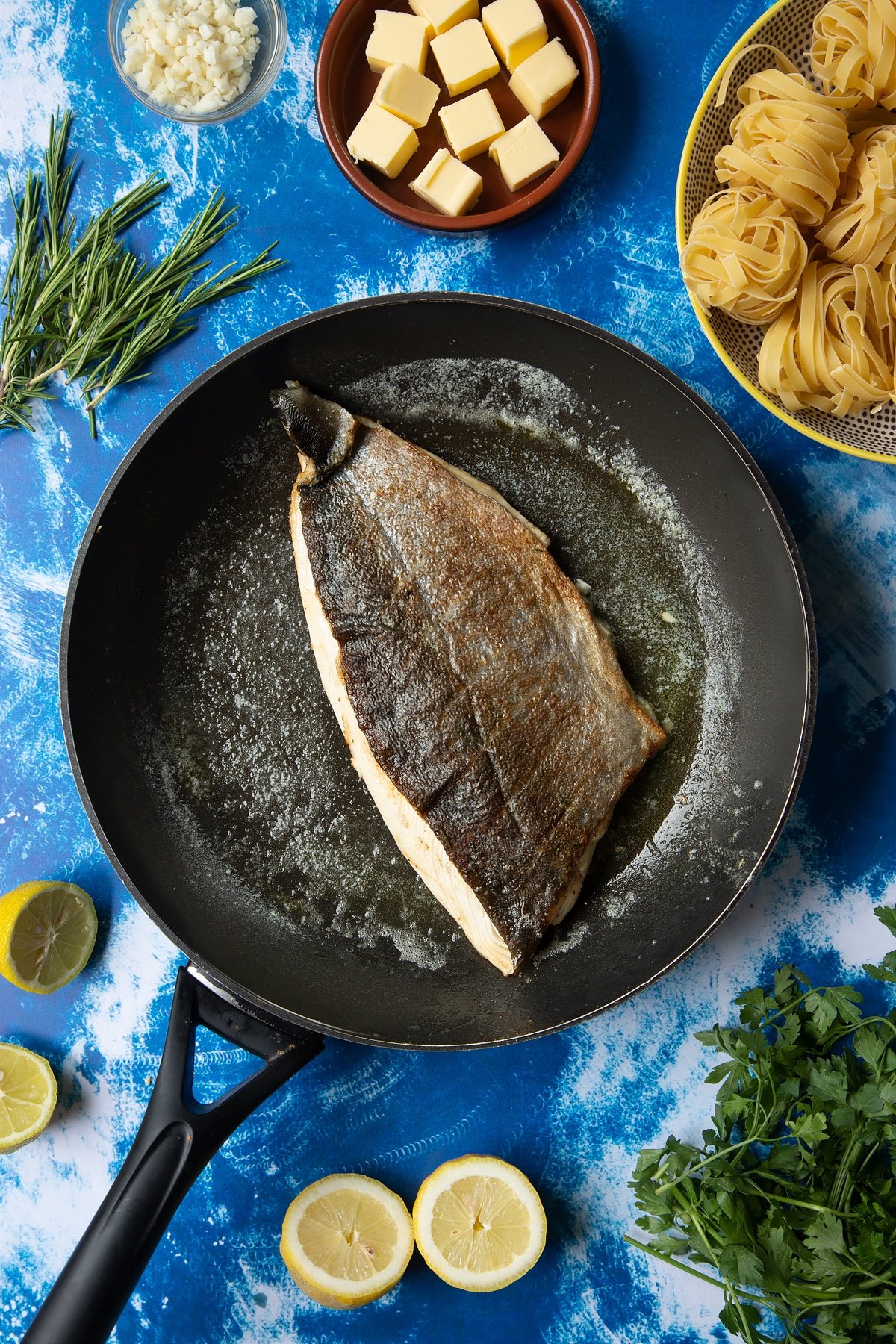
Cook the fish for a further 3 minutes while basting the top with the butter. Occasionally move the fish gently in the pan to stop it from sticking.

Once the fish is cooked, remove from the pan and set on a plate to rest on a serving dish. (See the FAQ for notes on deboning, especially if serving to children.)
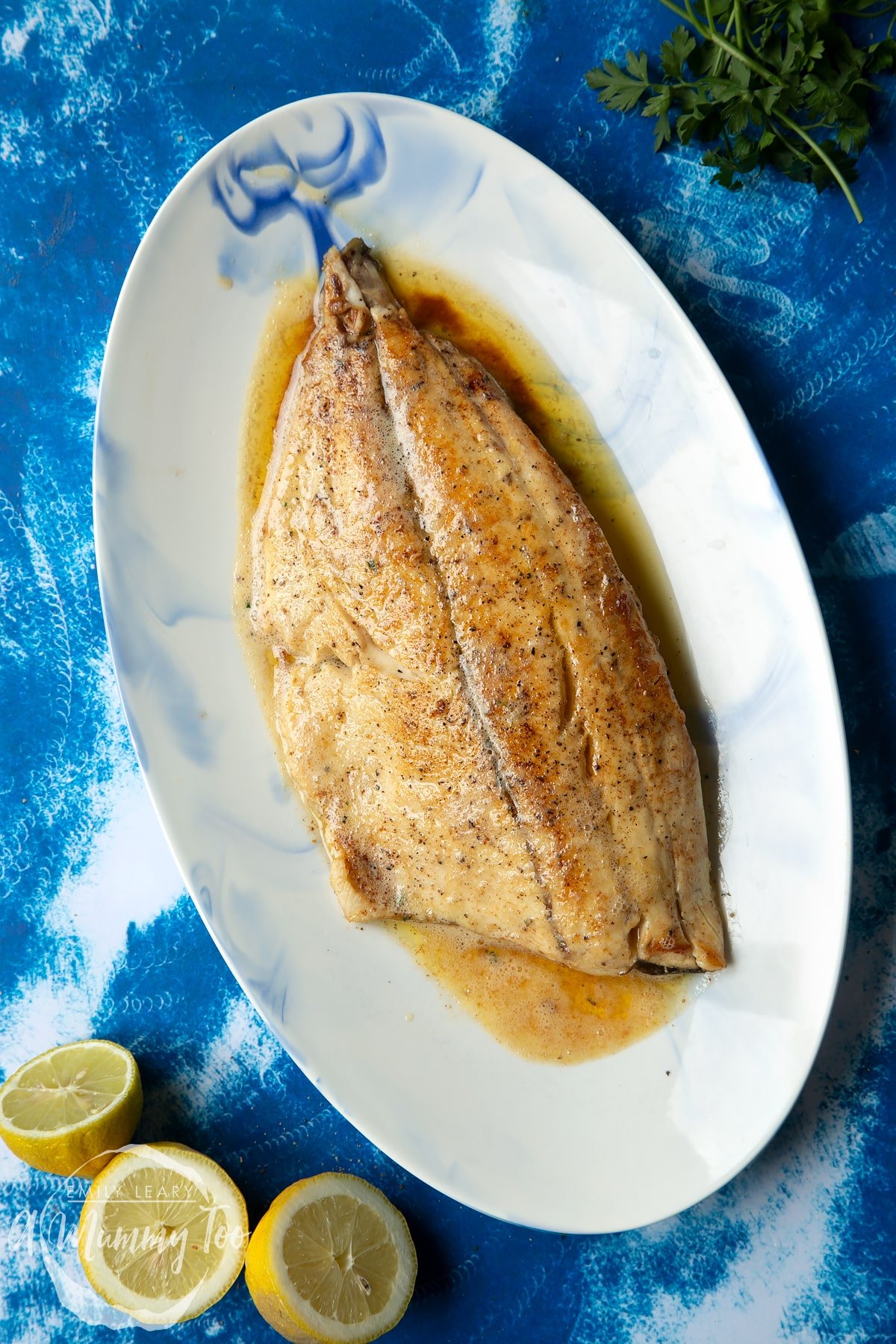
To finish the pasta, add the garlic to the buttery pan and fry for 30 seconds.
Add the garlic to the pan.
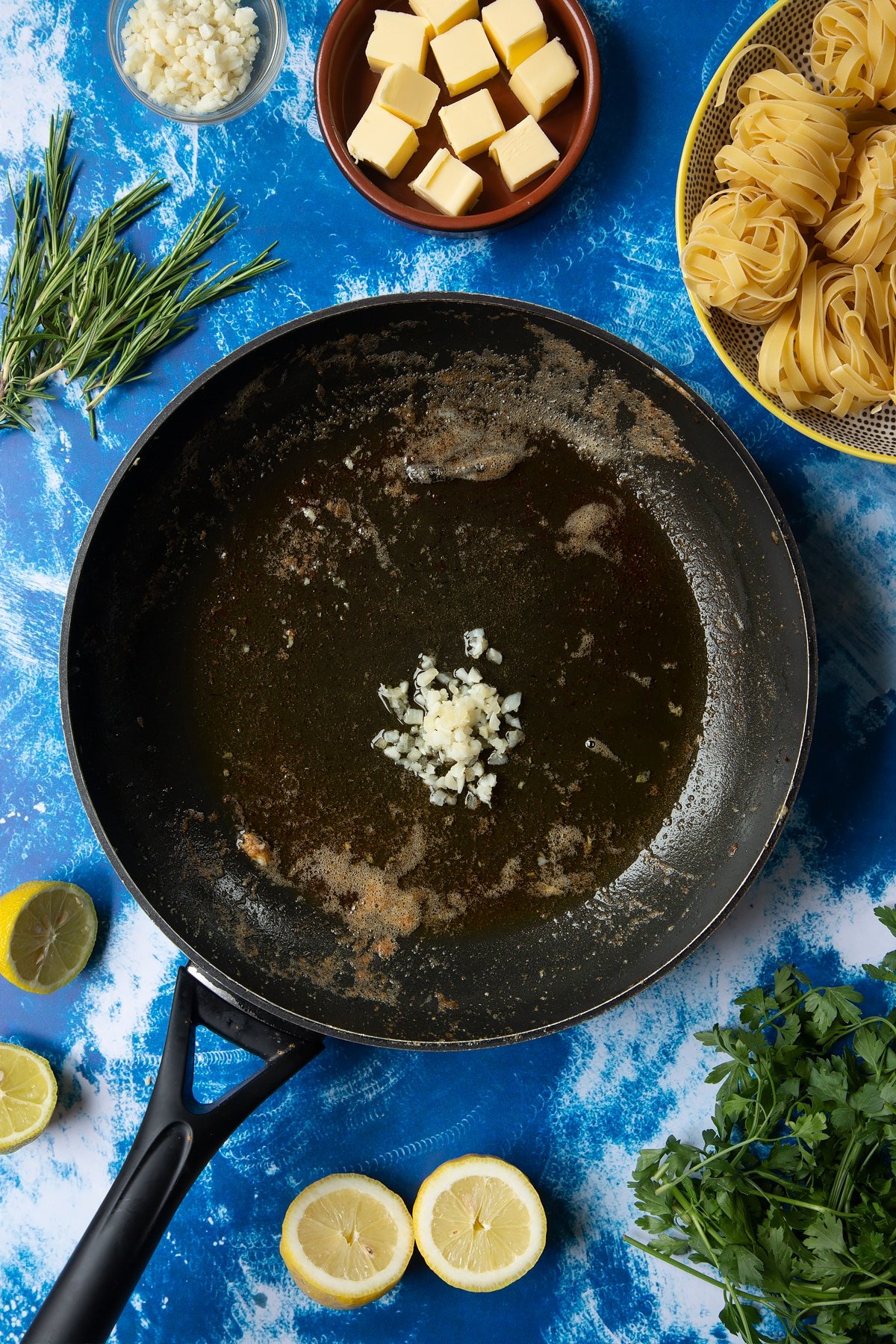
Cook for 30 seconds.

Drain the pasta, saving a tablespoon or two of the cooking water. Add the pasta to the pan along with the rosemary and half the parsley.
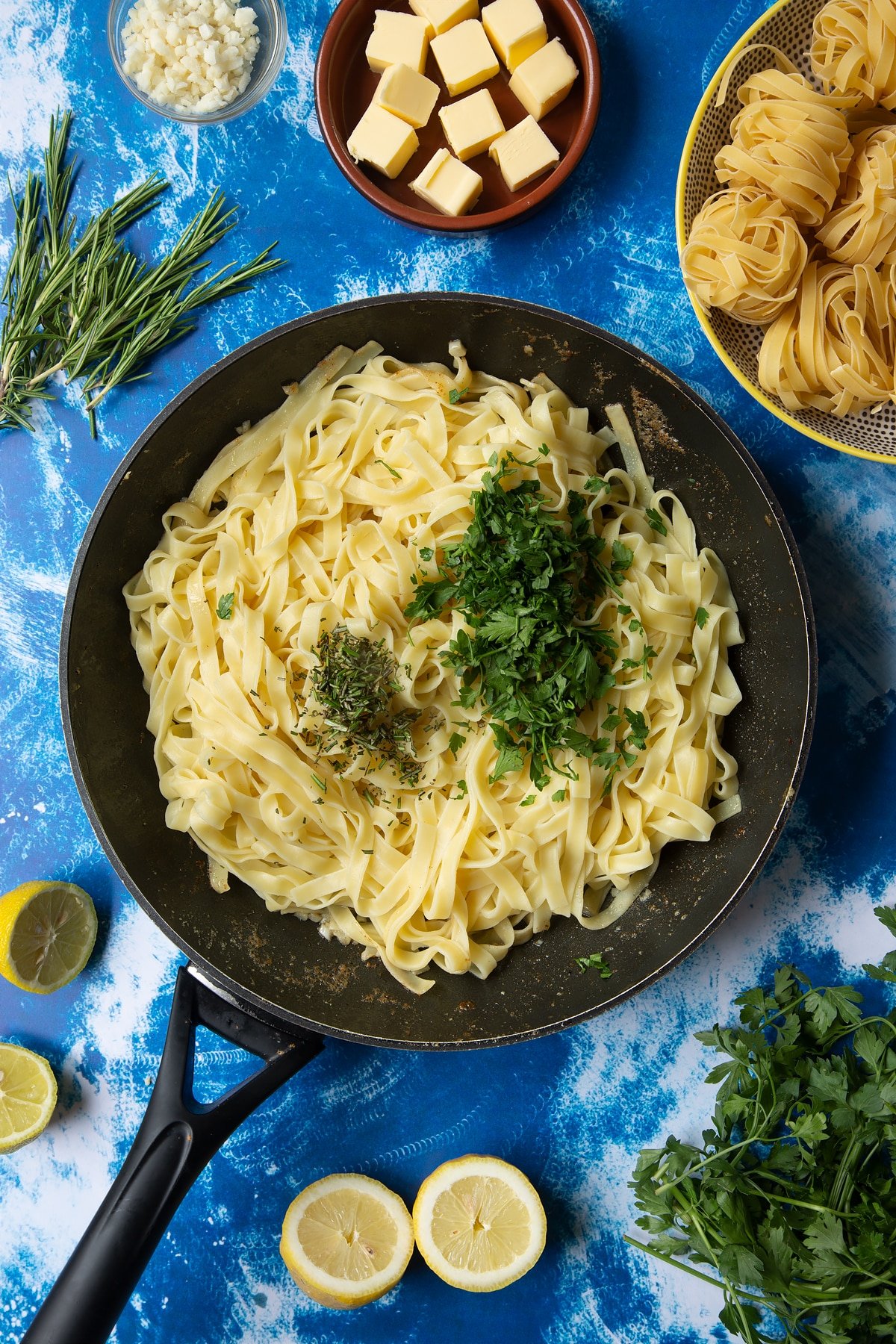
Toss the pasta in the frying pan, adding the reserved cooking water if you want a little more sauce.
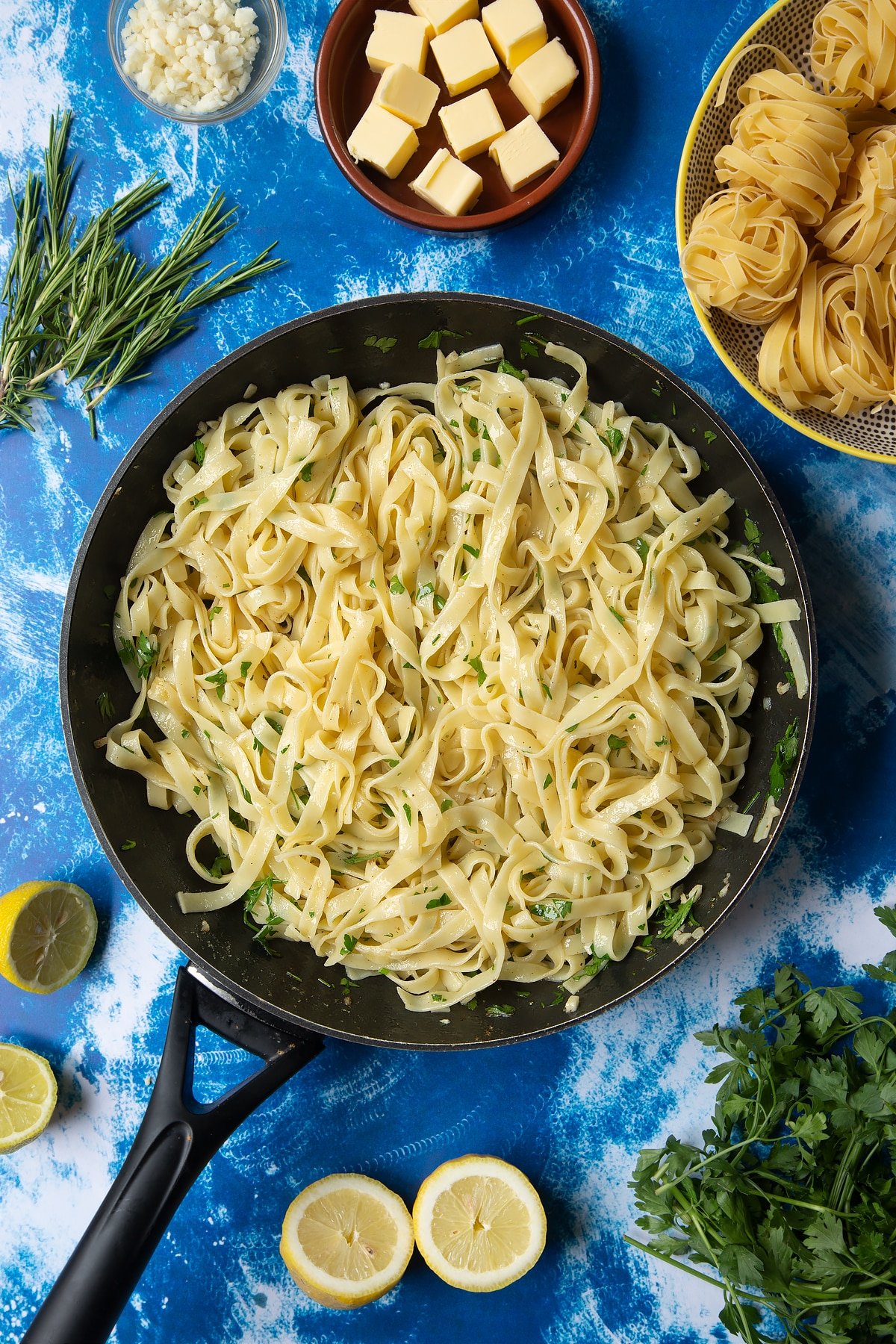
Transfer the pasta into a large serving bowl.
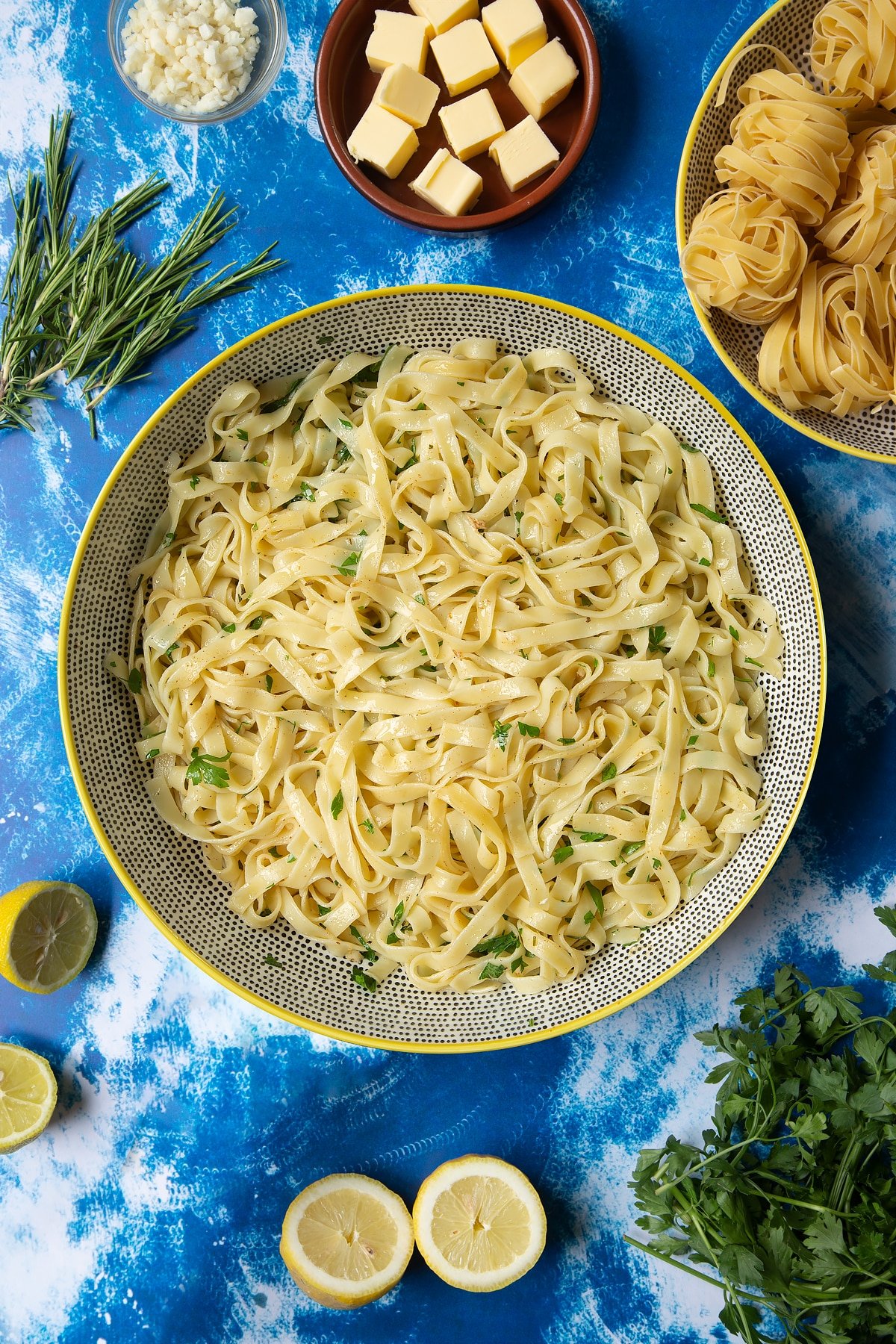
Serve everything to the table with lemon wedges and a scattering of the remaining parsley.
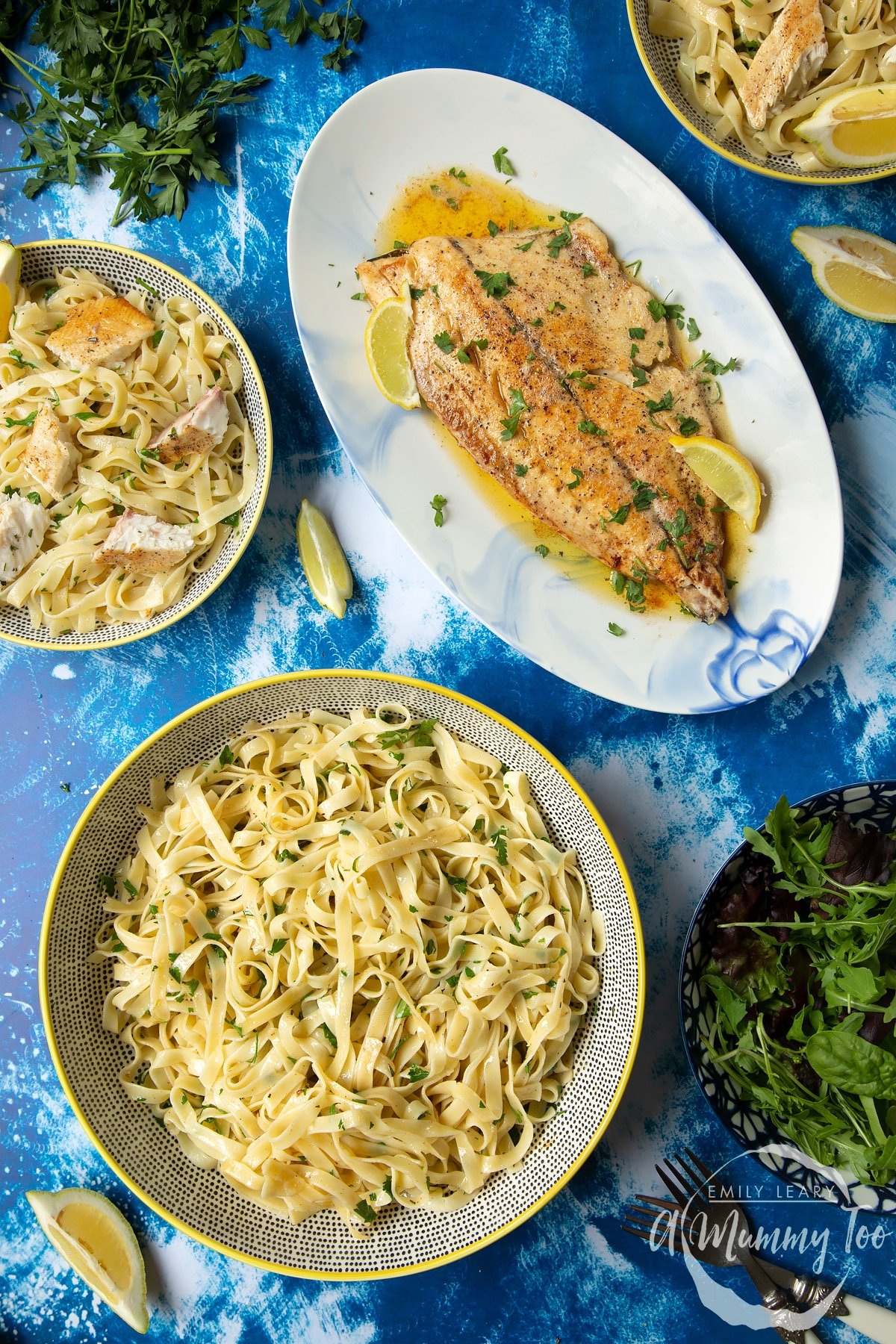
Invite everyone to dig in!
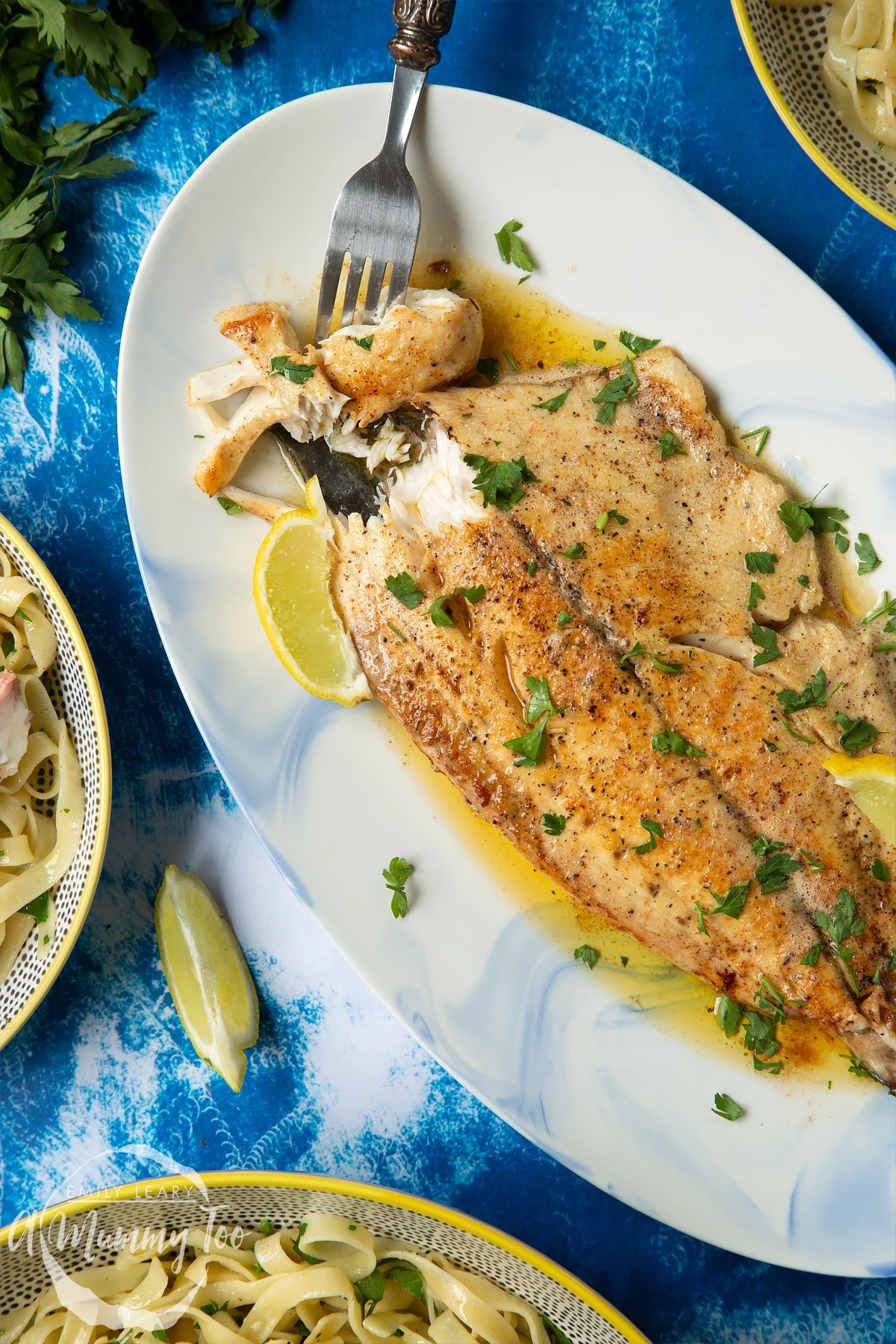
It's such a joy to pile the herby, garlicky tagliatelle into bowls and top with generous chunks of perfectly cooked, buttery Yellowtail. A squeeze of lemon finishes the whole dish off perfectly.
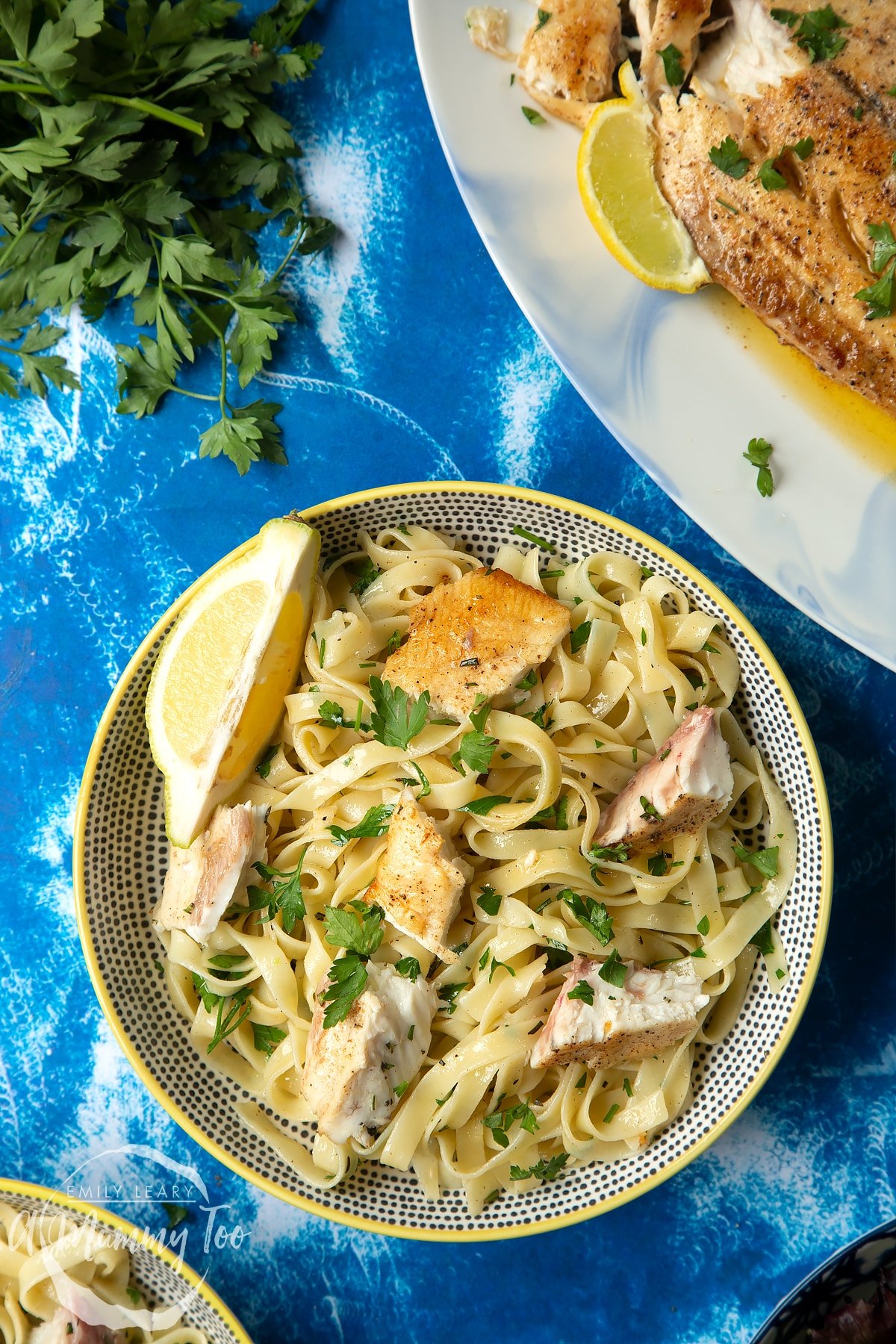
Pointers, tricks and troubleshooting tips for the perfect pan-fried Yellowtail
Is recipe easy to make?
Even if you've never cooked with raw fish before, you will be fine cooking this pan-fried Yellowtail tagliatelle!
You only need simple ingredients (tagliatelle, butter, garlic, rosemary and lemons) and Dutch Yellowtail is honestly such an easy, forgiving fish to work with you're going to get great results.
What's more, you're going to use the same delicious butter you fry your fish in to make your pasta sauce, so the whole thing takes under 20 minutes!
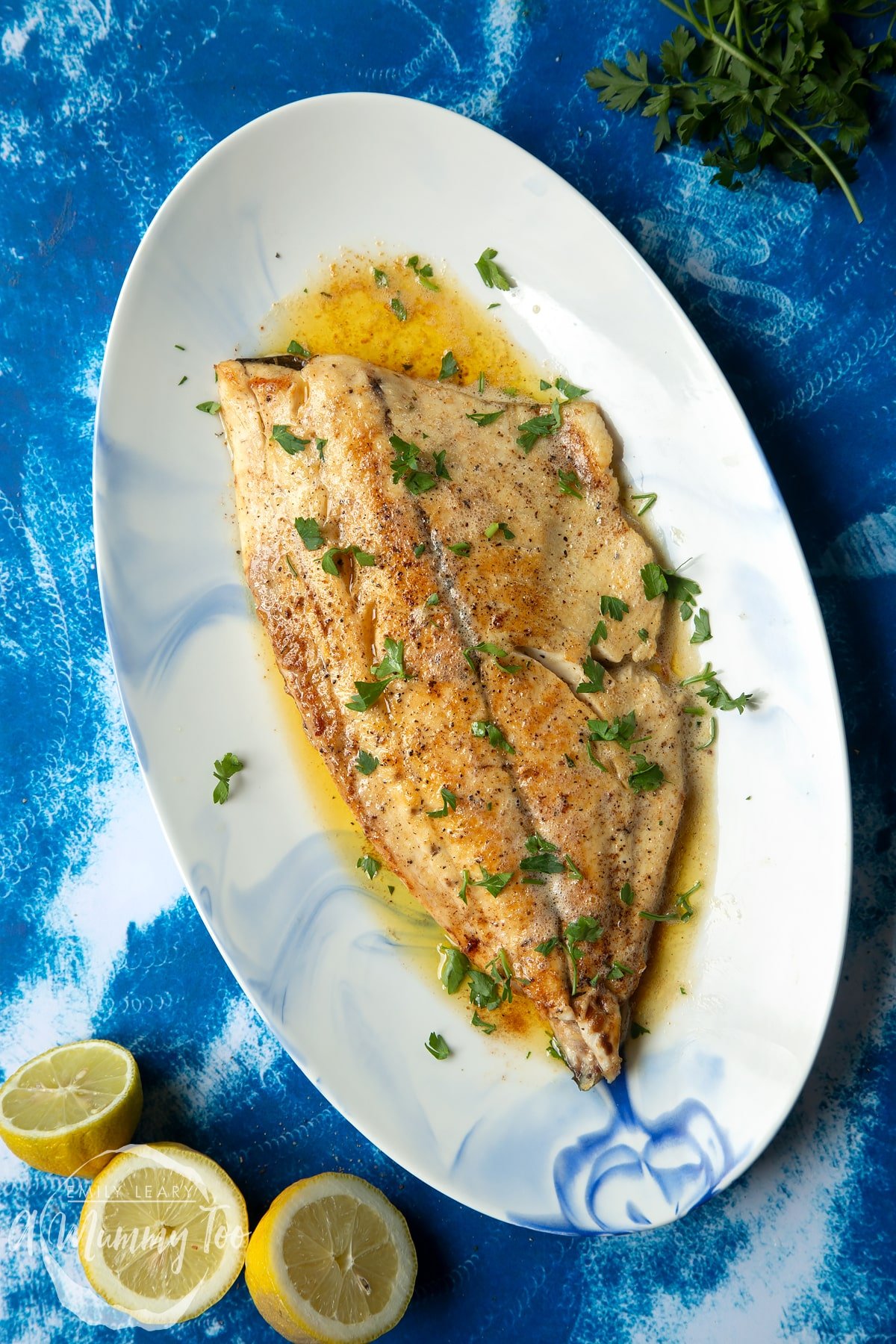
Will I need any special equipment to make pan-fried Yellowtail tagliatelle?
You won't need any special equipment to make this recipe. Just grab weighing scales, a kitchen knife, a chopping board, tweezers (for deboning), a large frying pan, a large saucepan, a colander and a slotted spatula and you're good to go.
Where can I buy Dutch Yellowtail?
In the UK, you can currently pick up fillets and whole Dutch Yellowtail at any Wholefoods Market with a fish counter. At the time of writing, this includes Kensington High Street, Fulham, Richmond and Piccadilly.
Dutch Yellowtail is not yet available in the US to buy in grocery stores but is available on the menu at Truluck’s and Blue Sushi Sake Grill.
How can I tell if my fish has gone off?
Ideally, you should purchase fish on the same day you intend to cook it.
If that's not possible, your fish should be placed in the refrigerator as soon as you get home. Keep your fish wrapped up and place on ice to keep it well chilled.
Whole fish should keep for an absolute maximum of three days when properly stored. Fresh fillets are more exposed to air and so will generally keep for a maximum of two days.
Always check with your fishmonger as the timings and storage advice can vary slightly for different fish and different cuts. (For example, shellfish require a different approach to storage).
If your fish has a Use By date, always heed this.
If you've stored your fish correctly and within the advised time limits, you can use your senses to judge if it's safe.

Sight
Your fish should look fresh and bright? The eyes should be bright, bulging and clear. The flesh inside the gills should be red.
Has your fish changed colour or shape? Have the eyes turned cloudy or sunken? Are the gills dull, purple or brown? Do the scales or flesh look dull, faded or slimy?
If your fish is showing these or any other signs of degradation or contamination, it's time to throw it away.
Remember, you can't see bacteria on food, so if your fish has been handled unhygienically (e.g. by someone with unwashed hands) this will not show up. This is why it's important to buy good quality fish from a reputable fishmonger and to practice good hygiene practices yourself when handling the fish.
Smell
Fresh fish only smells mildly. If it smells more strongly, it probably isn't fresh and if it smells very strong, it's best not to eat it.
Touch
Fresh fish should feel firm and wet, older fish can develop a film or become slimy, it may also become softer.
If it doesn't feel absolutely fresh, it's not worth risking.
How should I remove the bones from a Dutch Yellowtail fillet?
If you're cooking for adults, you could serve your Dutch Yellowtail with the bones in place as they reveal themselves quite readily when you serve yourself the pieces of cooked fillet.
Just make absolutely sure to tell everyone at the table to look out for them.
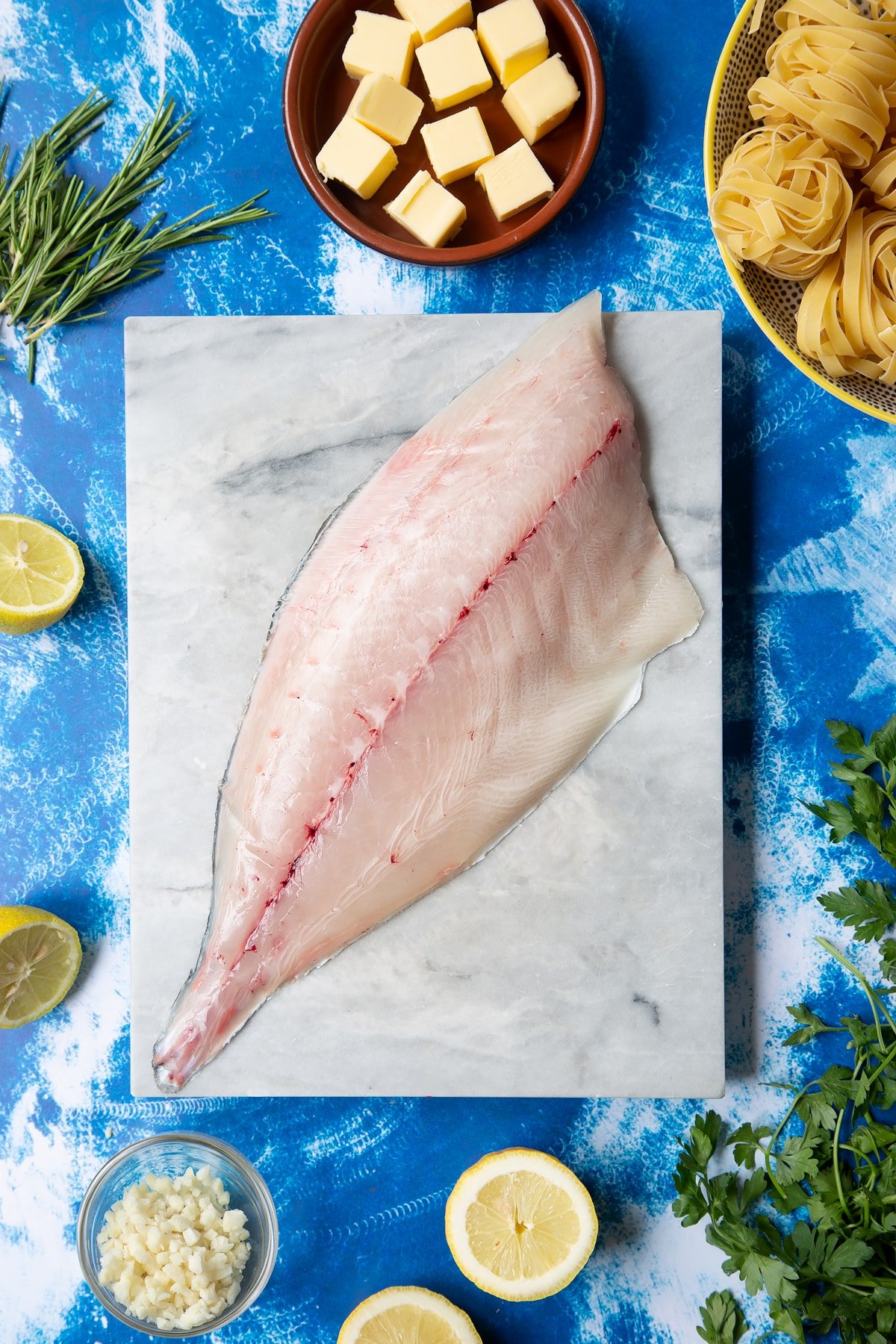
However, if you wish to serve your fish without pin-bones, especially if you're feeding children, you have three options for removing them:
- Ask your fishmonger to remove them. Simply request that the pin bones are removed when you buy your fillets.
- Cut the bones from the raw fillet. Place the raw Dutch Yellowtail fillet on a clean surface and slice down either side of the pin bone line (the red line that runs down the centre of the fillet) starting no more than halfway down from the tail. This will create a thin v-shape strip of flesh containing the bones, which you can remove. This video demonstrates the v-cut method.
- Remove the bones once cooked. Keep the fillet in one piece, cook as per the recipe, and then remove the bones with tweezers before serving.
Why did my Dutch Yellowtail fillet curl up in the pan?
The skin of your fish fillet will retract as it cooks and crisps up. To avoid this, make sure you don't skip scoring the skin. A few light slits with a sharp knife will give the skin room to shrink without causing the fillet to curl up.
How can I get a crispy skin on my Dutch Yellowtail fillet?
Frying your fillet skin side down in butter over a medium heat should help you get a crisp skin. However, if you find your fillet skin a little less crisp that you'd like, you can place the fillet on a baking sheet skin side up and under a hot grill for just 30 seconds or so. This should crisp the skin up nicely.
Is this pan-fried Yellowtail tagliatelle suitable for vegetarians or vegans?
No, this recipe is not suitable for vegetarians or vegans as it uses fish as a key ingredient. It is, however, suitable for pescatarians.
Is pan-fried Yellowtail tagliatelle gluten-free?
This recipe uses wheat-based pasta so is not suitable for a gluten-free diet.
However, none of the other ingredients in this recipe naturally contain gluten, so if you use a gluten-free pasta, the whole recipe should then be suitable for a gluten-free diet.
Make sure to check the labelling on everything you use if you’re cooking for someone has a gluten allergy, intolerance or coeliac disease.
Is pan-fried Yellowtail tagliatelle keto-friendly?
Fish and butter are keto-friendly, but wheat pasta is not. You could use spiralized vegetables in place of the pasta to make the dish suitable for a ketogenic diet.
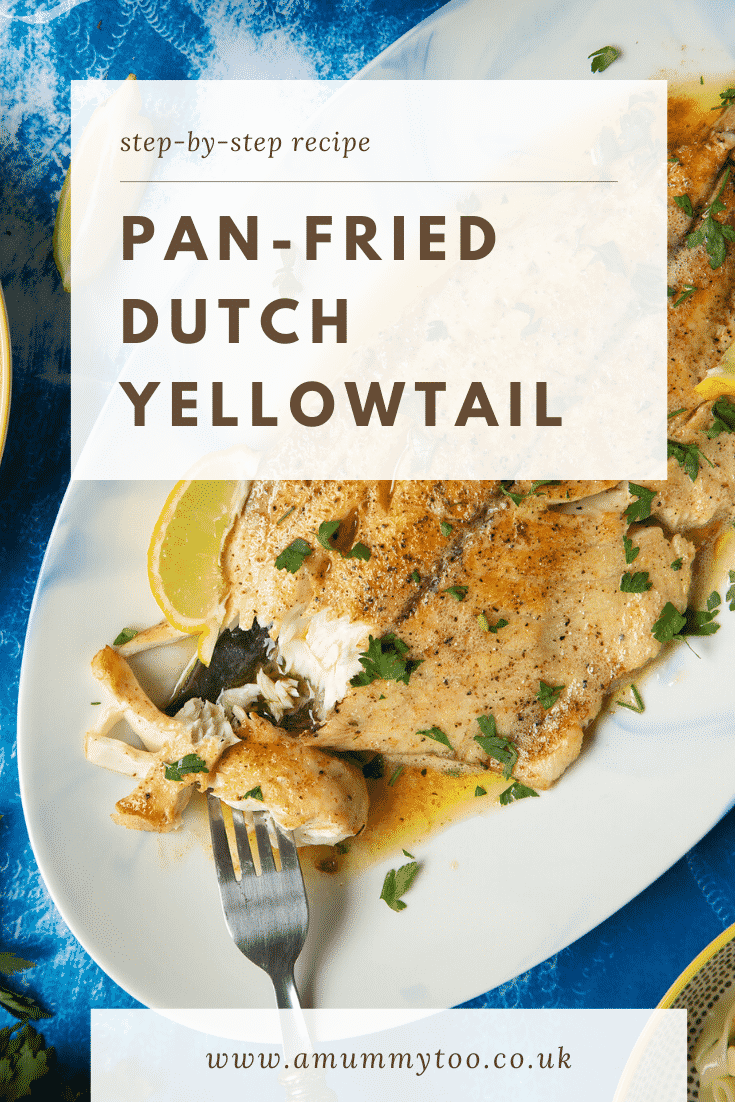
Is pan-fried Yellowtail tagliatelle healthy?
There's plenty of butter in this recipe, but the Yellowtail itself is high in protein and Omega-3 fatty acids, so there's plenty of good nutrition in this recipe. It can be enjoyed as part of a healthy, balanced diet.
Is pan-fried Yellowtail tagliatelle safe to eat while pregnant?
At the time of writing (June 2020), the UK National Health service recommends that it is safe for pregnant people to eat cooked fish and seafood, but states that "you should eat no more than 2 portions of oily fish a week, such as salmon, trout, mackerel or herring".
A Mummy Too does not offer medical advice. You can review the NHS advice here and you should consult with your medical professional regarding any concerns.
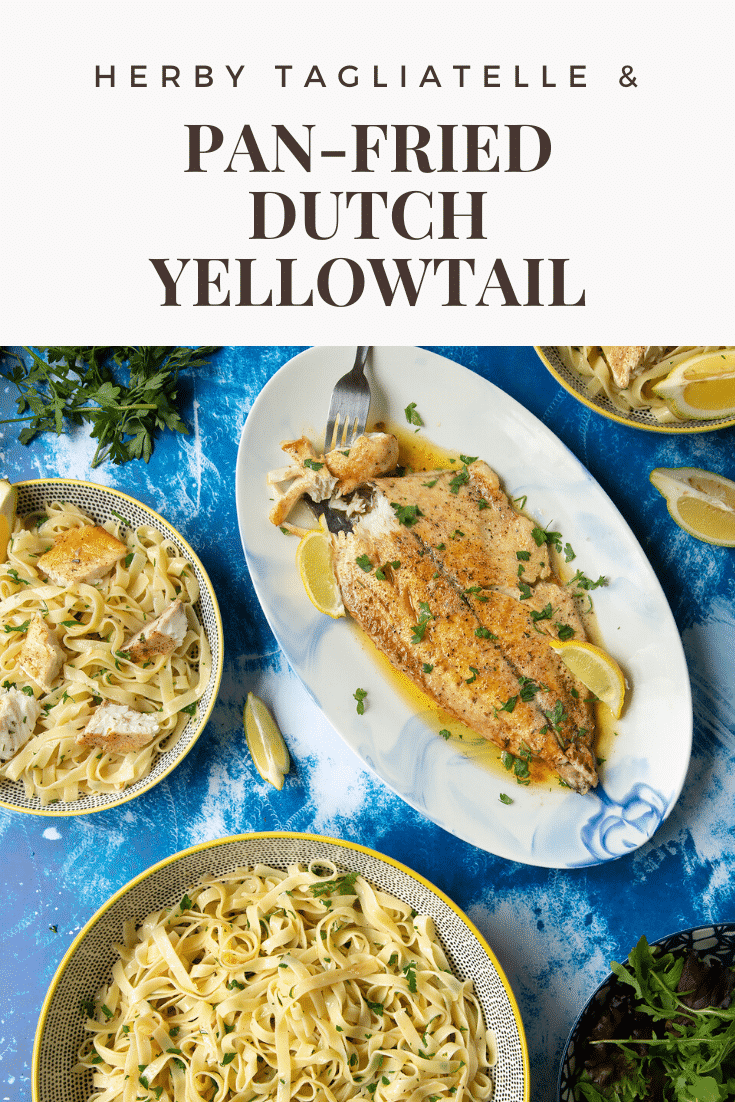
Can I make pan-fried Yellowtail tagliatelle recipe without the pasta?
You could certainly leave out the pasta and just make the fish. It would be lovely with some herbed new potatoes and lightly steamed Tenderstem broccoli.
I haven’t got fresh herbs can I use dried?
Dried herbs will not give the same fresh taste, but they can be used.
As a rule, 1 tablespoon of fresh herbs is equal to 1 tsp of dried, so you'll need just a pinch of dried rosemary and less than a teaspoon of dried parsley.
Add them to the butter with the garlic and allow them to soften before adding the pasta.
Don't use dried herbs to dress your served dish like you would with fresh as the texture will be unpleasant.
Can I add extra herbs to this recipe?
You can certainly add extra fresh herbs to this recipe. It's best to go by taste, though. Add the recommended amount, then taste and add more if you wish.
You could also experiment with different herbs. Sage or tarragon could work well in place of the rosemary.
How should I store pan-fried Yellowtail tagliatelle?
Once cooled, place your pasta in a sealed container and into the refrigerator within 2 hours of cooking.
Likewise, place your cooked, cooled fish in a separate sealed container in the fridge within 2 hours. Keep your fridge temperature at 5C or below.
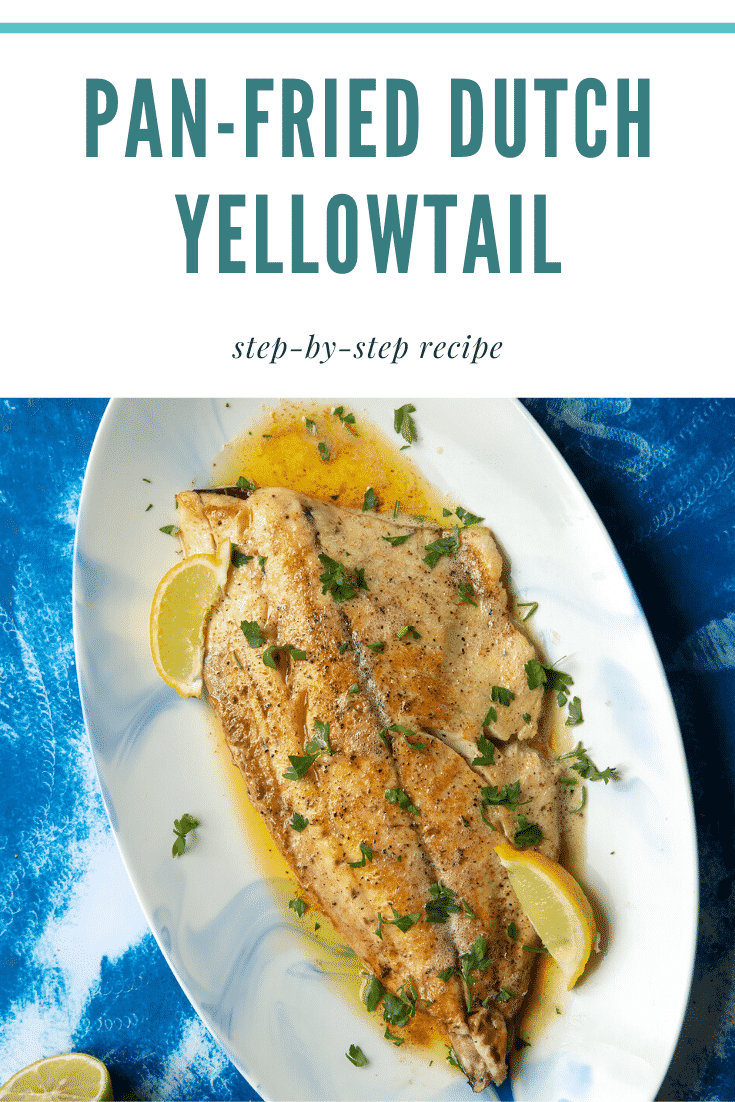
How long does pan-fried Yellowtail tagliatelle keep?
Placed in the fridge within 2 hours of cooking and properly stored in a sealed container, your fish should keep for 2-3 days.
Can I leave pan-fried Yellowtail tagliatelle out on the counter?
No, you should not leave cooked fish or pasta out on the counter. Any that has been left at room temperature for more than 2 hours should be thrown away.
Can I make pan-fried Yellowtail tagliatelle ahead?
I wouldn't recommend trying to make this recipe ahead. You're best to use fresh fish, cooked and served on the day of purchase.
Can I freeze pan-fried Yellowtail tagliatelle?
If you have any leftovers that you're not going to eat within a couple of days, you can freeze them.
Once cooled, place your pasta in a sealed container and into the freezer within 2 hours of cooking.
Likewise, place your cooked, cooled fish in a separate sealed container in the freezer within 2 hours. Aim to leave as little empty space in the container as possible to avoid freezer burn.
Your fish and pasta should keep in the freezer for up to a month. When you are ready to eat them, transfer them to the fridge and allow them to defrost overnight.
What is the best way to reheat Yellowtail tagliatelle?
I would suggest enjoying this dish cold, rather than reheating.
Fish is really easy to overcook, so reheating risks chewy fish. However, if you're keen to enjoy your leftovers hot, wrap the fish in foils and place on a baking tray in a low oven (about 140C) until warmed through.
Pasta, too, can suffer if not correctly reheated, tending to either break up or soften. To reheat your herby pasta, place in a wide pan with a couple of tablespoons of water and heat gently. Chilled pasta tends to stick together, but as it heats, the water you added will help to loosen it. Only then should you begin to stir until it is safely heated through.
Can I make pan-fried Yellowtail tagliatelle in a different quantity?
It’s very easy to adjust this recipe to make more or less.
Simply scroll down to the recipe card towards the bottom of this post and hover your mouse (or tap your finger) over the portion number.
You will then be shown a slider, which you can move up and down to change the number of portions the recipe will make. As you do so, all of the ingredient quantities will automatically change accordingly.
If you have any questions about changing the quantities, just ask!
Can I make pan-fried Yellowtail in individual portions?
Yes, if you prefer, you can cut the fillet into four with a very sharp knife before frying. Be sure to score the skin of each individual piece and take care to turn carefully in the pan so that they don't break up.

What goes well with pan-fried Yellowtail tagliatelle?
This buttery, herby dish is perfect to enjoy with fresh salad and a crisp white wine, such as a Pinot Grigio.
Print this pan-fried yellowtail pasta recipe
Pan-Fried Yellowtail Tagliatelle Recipe
Ingredients
- 500 g (18oz lb) Dutch Yellowtail fillet skin lightly scored
- 350 g (12 oz) dried tagliatelle
- 80 g (5 tbsp) salted butter
- 2 cloves (2) cloves chopped
- 20 g (⅔ cup) fresh rosemary leaves roughly chopped
- 5 g (2 tbsp) rosemary de-stalked and finely chopped
- 2 lemon cut into wedges
- salt and black pepper to taste
Instructions
- In a large pan of salted water cook your pasta following the packet instructions. It should cook for no more than 10 minutes to become al dente (i.e. with a little bite).
- Meanwhile, place the Dutch Yellowtail fillet on a clean surface and season with salt and pepper on both sides. (See the FAQ for notes on deboning, especially if serving to children.)
- Lightly score the skin – the will prevent the fish from curling during cooking.
- Melt the butter in a large nonstick frying pan over a medium heat.
- When the butter is gently bubbling, place the fish fillet in the pan, skin side down.
- Cook until the skin is starting to go crisp, about 4 minutes.
- Carefully turn the fish using a slotted spatula and cook for a further 3 minutes while basting the top with the butter. Occasionally move the fish gently in the pan to stop it from sticking.
- Once the fish is cooked, remove from the pan and set on a plate to rest on a serving dish. (See the FAQ for notes on deboning, especially if serving to children.)
- To finish the pasta, add the garlic to the buttery pan and fry for 30 seconds.
- Drain the pasta, saving a tablespoon or two of the cooking water. Add the pasta to the pan along with the rosemary and half the parsley.
- Toss the pasta in the frying pan, adding the reserved cooking water if you want a little more sauce.
- Transfer the pasta into a large serving bowl.
- Serve everything to the table with lemon wedges and a scattering of the remaining parsley.
Video
Notes
Nutrition
This is a commissioned post for Kingfish Zeeland
Pin this pan-fried Yellowtail pasta recipe
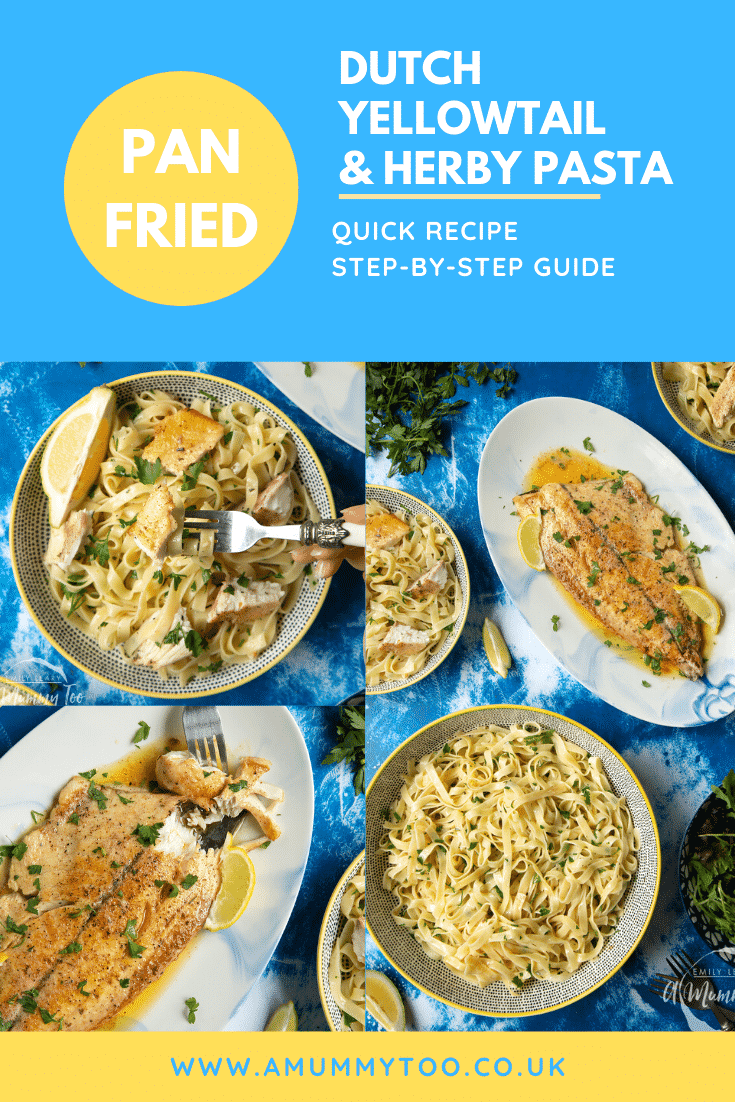
More fish recipes to try
Have you got my book?

'This is a great kids cookery book. Emily is a star' - Simon Rimmer
'The book I'd like to force into any mother's kitchen' - Prue Leith
"A fab book with a plan." - Jane Devonshire, 2016 Masterchef UK winner
'Emily has managed to combine her mummy knowledge and passion for food to make a truly helpful and brilliant cookbook' - Priya Tew, RD, BSc (Hons), Msc
Get Your Kids to Eat Anything is an achievable 'how to' for parents in the battle to overcome picky eating and 'make new the norm'. Emily Leary's unique 5-phase programme looks at the issue of 'fussy eating' in a holistic way that links imagination with food, and which situates parents alongside - not in opposition to - their children.
.

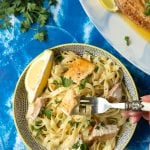

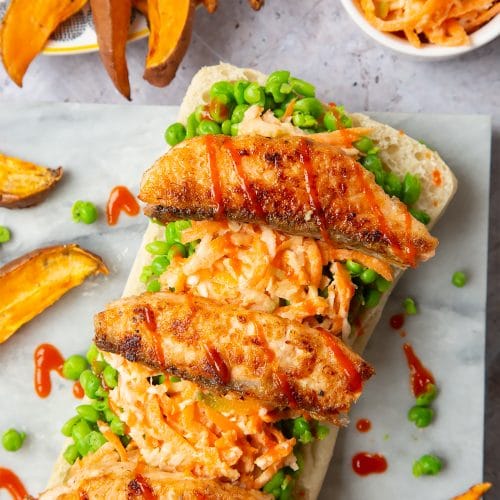
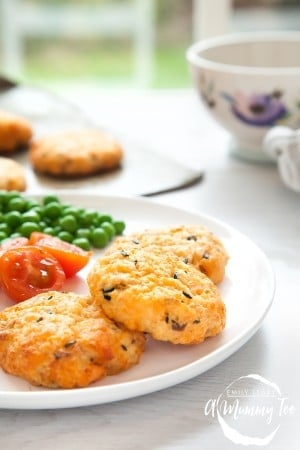
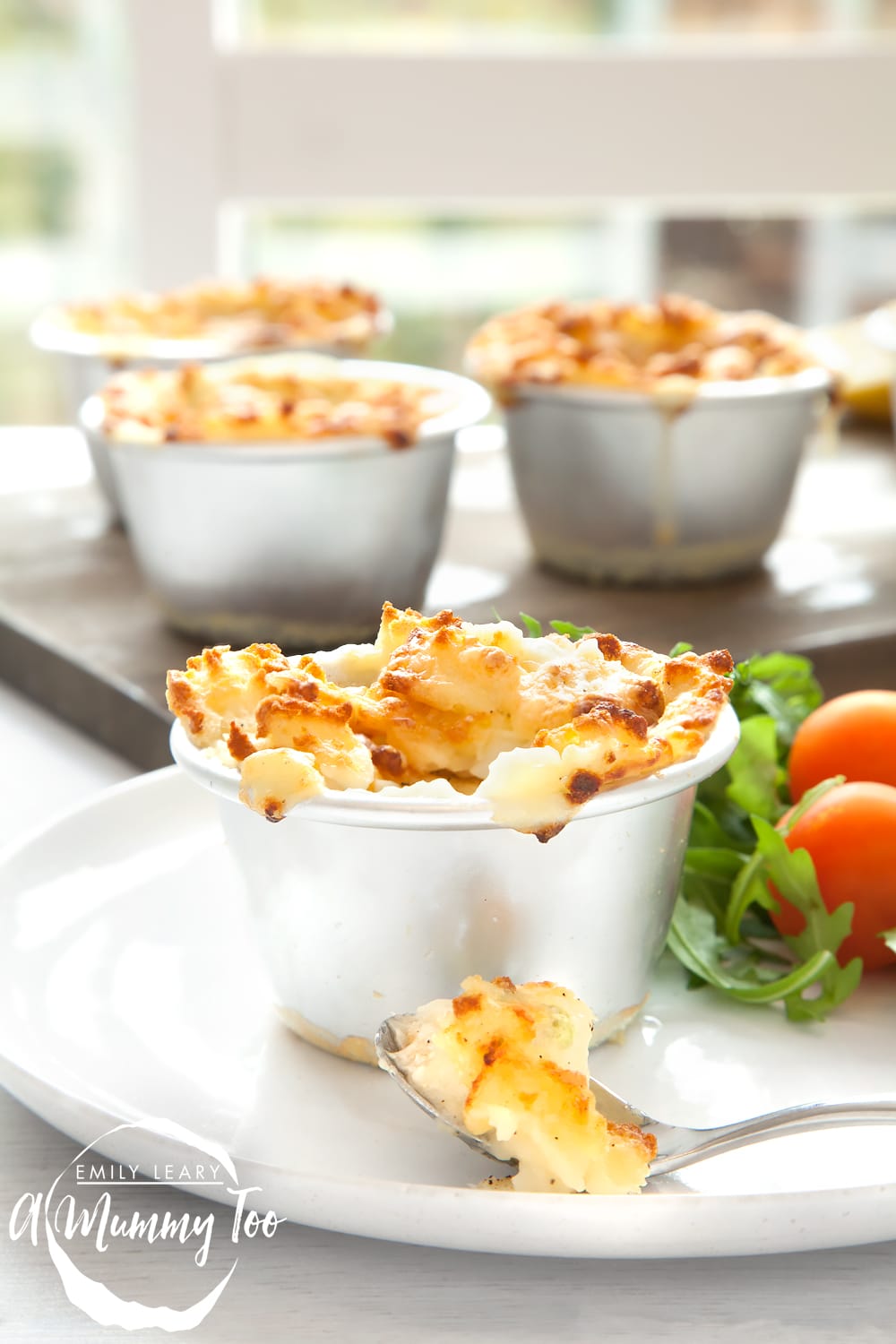
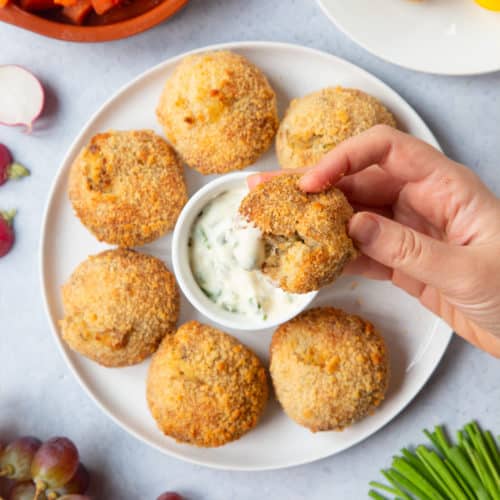
Leave a Reply